Fragged Empire by Evil Mastermind
Alone, together, in the dark
Original SA post LET'S READ FRAGGED EMPIRE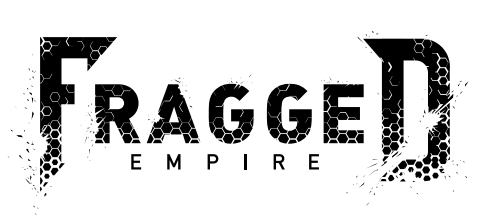
Part One: Alone, together, in the dark
Over 10,000 years ago, Humanity went extinct after reaching a point of social, technological, and genetic stagnation.
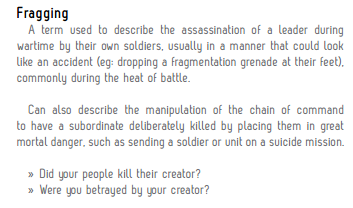
Before we died out, we created our child race: The Archons. The Archons mastered genetic engineering and began populating the galaxy with thousands of newly created races that served as children, pets, servants, or mistakes to be pushed to the backwater corners of the empire and forgotten.
In their pursuit of genetic perfection, the Archons created twelve "perfect beings": the X'ion. But when the Archons decided that the X'ion were actually a mistake and began killing them, one X'ion managed to escape into the deepest reaches of unexplored space.
X'ion returned 200 years later, bringing with it its own bioengineered warrior races: The Nephilim. X'ion had one goal; to destroy the Archons in revenge for being created only to be destroyed. The Archons created new warrior races such as the Legion in retaliation in order to defend themselves.
It wasn't enough.
Six years after it reappeared, X'ion had successfully eradicated the enitre Archon race. Its work done, X'ion abandoned the Nephilim and returned to deep space.
In the wake of the end of the war, the abandoned races saw no reason to continue fighting. What followed was a century of darkness as the various creations of the Archons and X'ion crawled out of the wreckage, attempting to rebuild their societies among the ruins. Or, in the case of the warrior races, create their own societies from scratch.
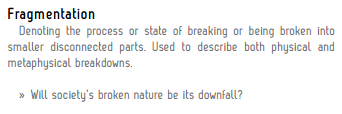
It took these hundred years for most of the races in the galaxy to rediscover interplanetary travel, and it has only been about five years since they've all met in a post-war situation. Faced with no other option, they are attempting to put aside bad blood and band together for survival. Because no single one of them can survive on their own, and nobody knows where these new societies are heading.
They need each other, whether they like it or not. The galaxy is full of abandoned bioweapons, autonomous death machines left over from the war, and space stations and colonies full of technology nobody really understands. And if they do not hang together in the face of the unknown and the remnants of the Great War, then they will most assuredly hang separately.

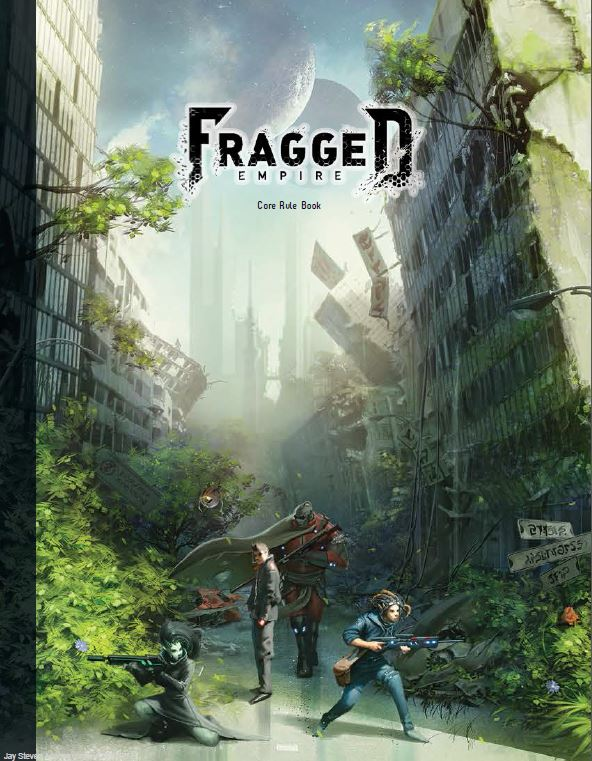
[url="http://fraggedempire.com/"Fragged Empire[/url] by Wade Dyer is a game that, I will admit, took me by surprise.
I saw the game (shrink wrapped) in one of my sort-of-local game stores next to a few other nice-looking sci-fi games, and the cover caught my eye. I liked the focus on the ruins the characters were stalking through, and the back cover blurb mentioned a "post-post-apocalyptic future" which was not something I've ever really heard of. But what really caught my eye was this section of the back cover:
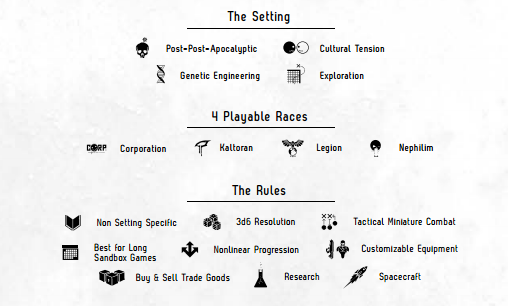
That may be the clearest I've ever seen a game's core concepts presented. I've seen it described as "eurogame-y", and I suppose that's as good a term as any. It's a nice, simple, clear list of the game's main points. This form of clarity will be cropping up throughout the book, and man I wish more games would do stuff like this.
I ended up buying the book few weeks later after checking out the free preview, and was amazed at how much I dug the setting and at how clearly presented everything is. I know one complaint about RPG books that comes up a lot is how they're generally not designed to be reference material alongside being reading material. Fragged Empire is designed to be both, and it shows. Pretty much every subsystem is cross-referenced at the beginning of its section to the other subsystems it works alongside. Each chapter has some full-page, amazingly clear summaries of how a roll breaks down or what the order of actions should be in combat.
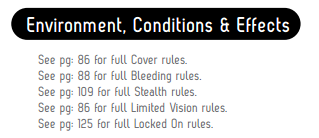
Like so.
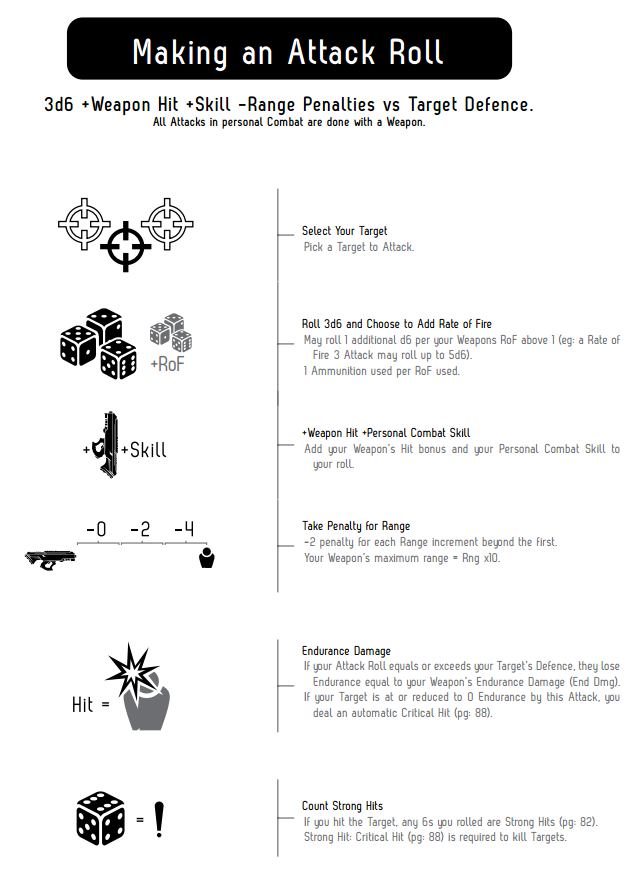
And like so.
So let's get to reading.
After some fiction, the book begins by getting into a little more detail about the four main themes/concepts of the game:
Post-Post-Apocalyptic Setting. Post-apocalyptic stuff is nothing new in games, of course. But FE doesn't take place right after everything went to shit, or in that period where everything stabilizes and everyone goes "whelp, I guess this is how things are now". FE takes place at the point where everyone is focused on rebuilding, and because of this most of the races are free to carve their own destiny and decide for themselves who'll they'll be, instead of being at the mercy of the progenitor races.
Cultural Tension. This is a bit of a two-branch idea. There were many races that were created during the Great War with no other purpose than to fight the other side. Now that the war's over and they've been left behind in one capacity or another, these races are in the unique position of having no choice but to create cultures for themselves as they go along to ensure their survival. In addition, all these races have only been interacting with each other for a fairly short amount of time, and even after all this time it's hard to forget that the species you're supposed to be friends with now was the one that bombed your home planet back to the stone age. So yeah...things can get tense.
Genetic Engineering. As stated, the Archons were created by humanity to replace us when we died out. Likewise, the Archons seeded the galaxy with races of their own design. Then the whole X'ion thing happened and it made a slew of self-aware bioweapon races. Everyone know their species was created by one side or another, and what they were made for. Even now, some of the races are creating their own slave species because people are incapable of learning from history.
Exploration. The new societies that are rising are built on the ruins of the Archon's society, which was in turn built on the remnants of human society. And since there was a century of not being able to contact other worlds, the whole galaxy has become the great unknown. Lost technologies, forgotten civilizations, possibly even alien races are all out there waiting to be discovered. The game is intended to be run sandbox style, with PCs exploring new areas to see what's out there.
When you get right down to it, Fragged Empire is sci-fi in the Firefly/Killjoys "we're a crew of freelance space vagabonds looking to survive" vein with a dash of Star Trek exploration and social commentary to taste.
And it's the social commentary aspect I really like. I feel like most RPGs would have taken the set-up (genetic engineered races bred for war whose creators are gone) and would gone the 40K-ish route of just having everything be a perpetual war because WAR IS ALL WE KNOW or something. But instead, Fragged Empire went the other way; once the Archons were wiped out and X'ion left, once things wound down everyone went "You know what? Fuck those guys who abandoned us" and stopped fighting. They rebuilt, or in the case of the war-built races started building from the ground up. I like that it's a post-apocalyptic setting that looks forwards instead of just being there, and I love the idea of these races creating their cultures as they go along because they were never meant to have a culture in the first place.
Anyway, I'm gushing a bit too much here, so let's move on to a brief run-down of the four core races. There are actually "thousands" of Archon and Zi'on created species throughout the galaxy, but these are the four that have risen to the "top of the heap" of the Haven System, which is where the game defaults to taking place.
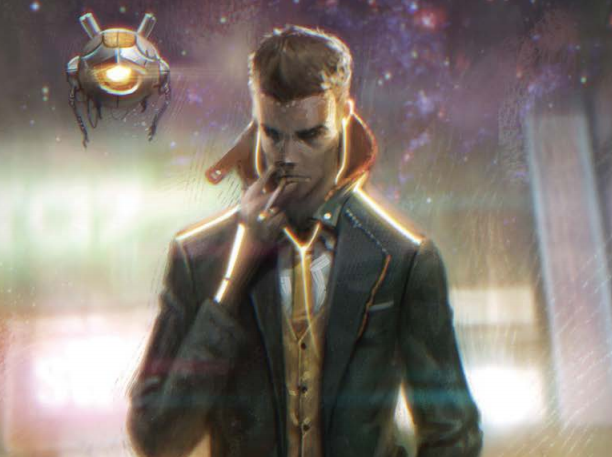
The Vargarti were one of the earliest creations of the Archons, and probably the ones the Archons hated the most. Seen as a failure, the Archons hindered their breeding ability and shuffled them off to one landmass on a planet that the Archons had egiven to one of their more-liked races. This actually worked to the Vargarti's advantage in the long run, because they were pretty much ignored during the Great War. Now free to expand, they discovered a forgotten city from the Golden Age of Humanity. There, they discovered not just humanity's technologies, but also the ancient ideology called "capitalism". Seizing this opportunity to remake themselves, they renamed their species to The Corporation, using capitalism as a cultural base, centered on the idea that everyone succeeds or fails based on their ability. The Corporation has gone from being stuffed in the back corner to being the central pillar of the new galactic economy and technological development.
(It's worth noting that the Corp aren't one big lowercase-c corporation; there are thousands of individual corporations that answer to a central government. Capital-C Corporation refers to the species as a whole. Also, while they look human, they have patterned skin around the shoulder/neck/top of head region; you just don't see it often in the art.)
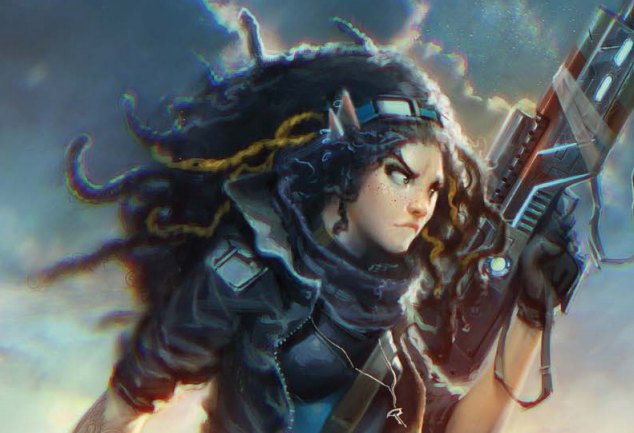
The Kaltorans were one of the Archon's favored races. Unfortunately, this made them a primary target for X'ion and resulted in the lush Kaltoran homeworld of Eden being overrun with X'ion monstrosities and the planet itself being orbitally bombed back to the Stone Age. The Kaltorians managed to pull back to the nearby planet of Kadash and were forced to hide in underground shelters to survive. The race was forced back to a tribal state, and fighting for the meager available resources was commonplace. The only reasons they survived were because of an inbuilt genetic memory and the adoption of a "whatever it takes to survive" mindset. Now, the current generations of Kaltorans are rejecting the crazy-bunker-survivalist stance of the elders and are stepping out to join the other races.
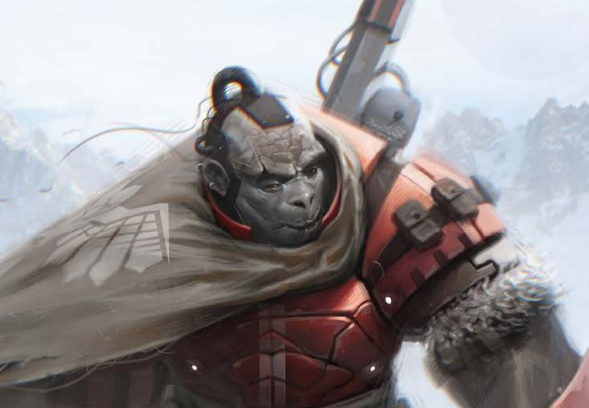
The Legion were the primary warrior race created by the Archons during the Great War. As a species, they've only existed for about a hundred years. They were built for battle, and as such were trained (and designed) to think about everything in military terms. When you get right down to it, they weren't really anything but battle fodder until the Archons were wiped out and the Legion started running out of supplies to fight the Nephilim with. At that point, they realized that they were on their own, and that they'd not only need to create their own society to survive as a race, but they'd also have to focus on procreation to keep the race going because they weren't really designed to breed. Contact with the other races has helped with the development of their own society, but it's proven hard for the Legion to break out of military thinking.
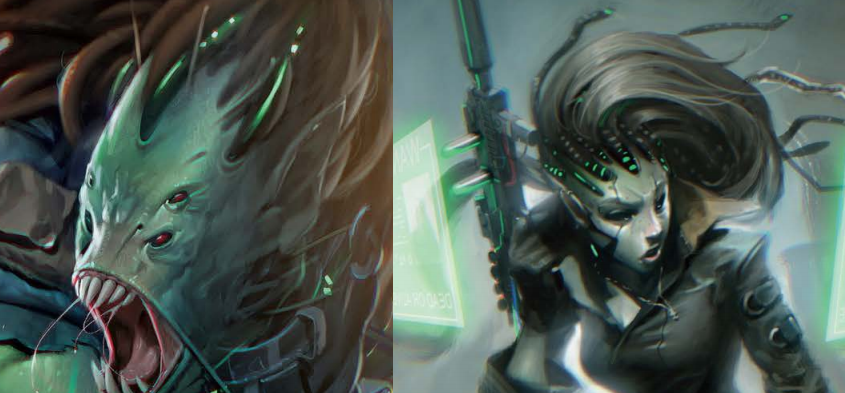
The Nephilim were also created to fight, but unlike the Legion were not intended to have self-awareness or free will. They were organized into Broods, one of which was called Devwi-Ich and tasked with the destruction of Eden and the Kaltorans. When X'ion abandoned it, Devwi-Ich went into stasis for 100 years, awakening and realizing that the only way it and its offspring could survive was to ally with their one-time enemies. This would require the Nephilim to start learning the alien concept of "empathy". The original Nephilim (called Purebloods) are gigantic spiked monstrosities that look like a cross between Doomsday and the Hulk. Realizing that it's hard for people to want to be nice to things that look like that, Devwi-Ich has begun engineering a sub-race called Emmisaries, who are designed to be visually appealing to the other races, and are subjected to a simulated childhood to help them learn how to get along with non-Nephilim.
In addition, the recently kickstarted soon-to-be-released Protagonist Archive I added four new races, which I'm going to touch on here because a) they're neat and b) I want to pad this post a bit.
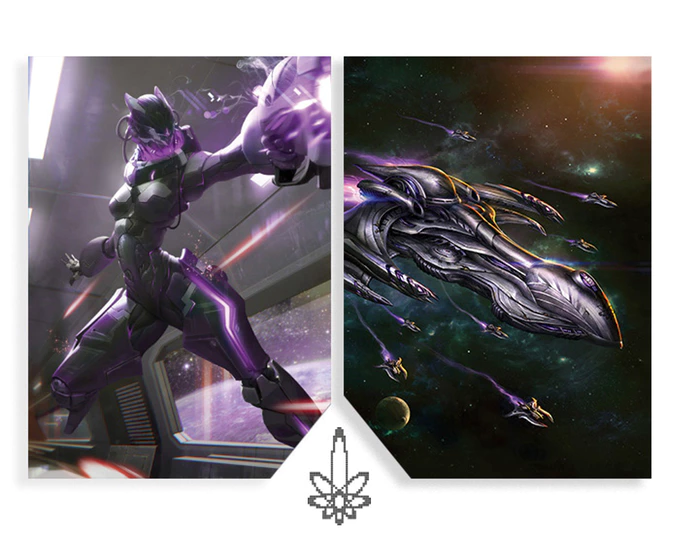
Near the end of the Great War, the Archons were getting desperate. Running out of options, they attempted to utilize humanity's ancient robotics technology to create a new fighting force called the Mechanoids, which were powered by human software adapted to combat mode. The Mechanoids then turned on their creators and became focused on the elimination of all organic life. What the Archons never knew was that they weren't altering software; they were warping the digitally stored sentient and fully aware minds of humans, which now called themselves The Palantor. Now, the Mechanoids seek to do the same to the Palantor that was done to them, forcing the Palantor to re-enter physical existence in Mechanoid bodies for their own survival.
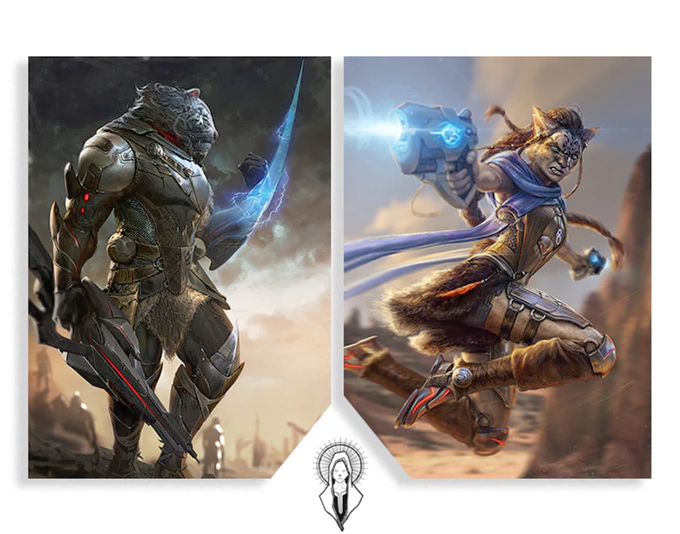
The Ursai were created by the Archons, but turned on their creators and sided with the Nephilim in the Great War. They were betrayed by the Nephilim in turn, and were wiped out. But this was not the end of them; an alien being known only as the "All-Being" arrived thirty years later and raised thousands of the Remnant from the dead before leaving. Now reborn with a new spiritual focus, The Remnant seek to redeem themselves and determine why they were saved.
(Fun Fact: The Ursai were the race that controlled the planet the Cargarti/Corporation were originally stuck on. The Ursai treated the Vargarti as slaves...but don't remember that at all since their resurrection, and for some reason no records of the slavery exist. This, unsurprisingly, pisses off the Corporation to no end.)
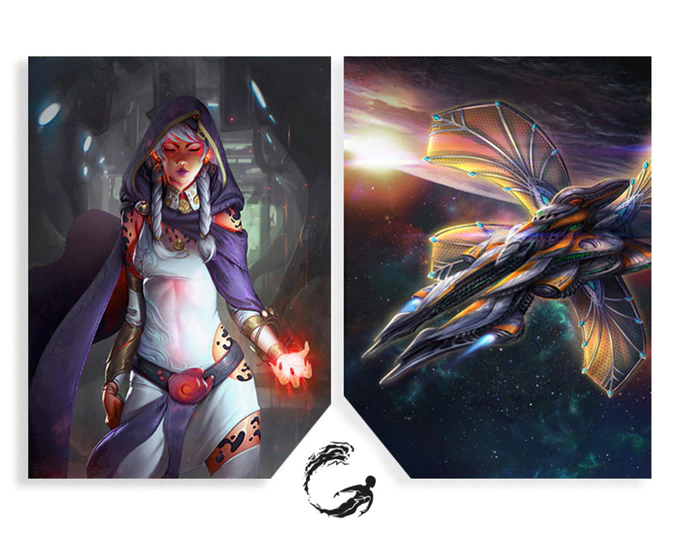
The Twi-Far are a spaceborn race that consists of two distinct species existing in one body. The physical half are the Twilinger, another Archon-created race that were intended as disposable cannon fodder. Not wanting any of that horseshit, the Twilinger fled into deep uncharted space where they encountered an energy-based alien (maybe?) race known as the Faren. The two species came together in a symbiotic relationship, and have returned to Archon space to experience the changes the galaxy is undergoing.
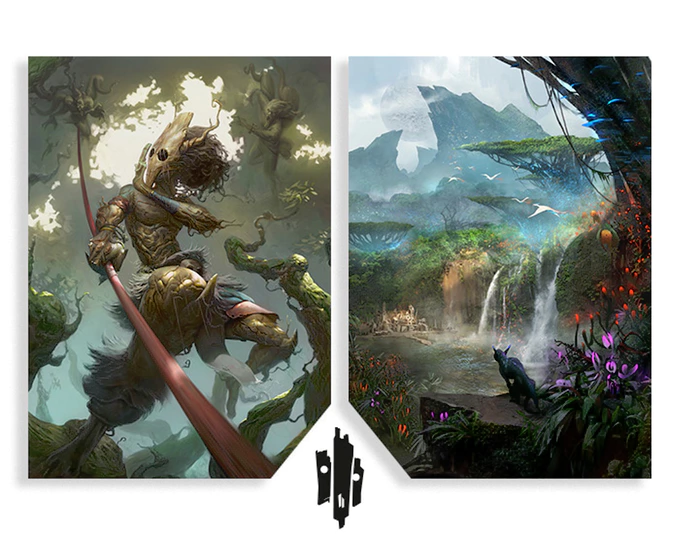
The Zhou were an Archon-created bioweapon race made using Nephilim genetic techniques. Originally, Zhou was basically a organic-tissue devouring grey goo scenario weapon; drop them on a planet, they multiply like crazy, let them eat up all the beings on said planet, let the Zhou starve to death, and clean up the mess afterward. What the Archons didn't expect was that when the Zhou was forced back on one planet, it would do something completely unexpected: adapt. The Zhou utilized their Nephilim genetics to grow as a unique species. They formed humanoid bodies out of the native plant life, and developed intelligence and self-awareness. All things strive. The Zhou as a species are still consumed by their hunger, but are careful to try to keep it under control because they know this is their only chance for survival as a species: every individual Zhou is potentially a planet-ending plague.
(By the way, check out the KS updates for how well Wade ran it. There's a lot of good behind-the-scenes stuff for the new races, and he's working on three new settings using the same base rules as FE.)
On top of those eight races, there are literally thousands of species populating known space thanks to the Archons and X'ion. Some of these are NPC-only deals, but they're out there.
So there we are. A rag-tag group of very different races with very different worldviews and very different goals all forced to rely on each other whether they like it or not.
Hope there's enough space out there for everyone.
NEXT TIME: How to do things, and how to make the people who will do them.
Characters, skills, and getting stuff
Original SA post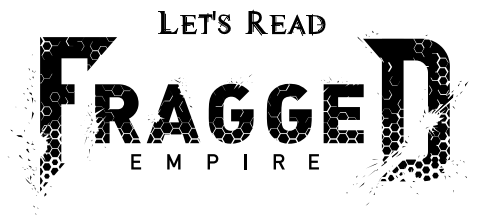
Part Two: Characters, skills, and getting stuff
A QUICK NOTE: Unlike my other reviews, I'm not going to describe every system in full detail. I'm going to skip things like general modifiers or the specifics of character abilities. The reason being that, unlike stuff like the Torg review, this is a "current" RPG and one I want people to go out and get if they like it. As such, I'm trying to not just transcribe the rules, but instead I'm just going to hit the main points. I don't think anyone's going to mind, but I just wanted to put that out there.
Fragged Empires starts with a quick run-down of the game's mechanical concepts (which I'll be covering in a bit), and goes right into character creation. I know it's usually not a good idea to leap right into character generation before rules concepts, but I can forgive the book because the core system is incredibly basic and (again) everything is cross-referenced to where you can get more detail.
But just to save some time: Fragged Empire works off a 3d6-plus-skill-beat-a-number system. When you use a skill, you roll 3d6, modify it based on your skill and possibly good description of your action, and roll to beat a target number. Any sixes rolled on the dice are considered Strong Hits, which can trigger special effects based on your character's abilities and gear.
So anyway, FE is a level-based with non-lineal character progression. Level is a representation of your available skills and resources, and leveling happens by default every three sessions.
When you make a character, you start at level 1 and pick your race. Each race gives you the expected modifiers to your Attributes and skills and such. It's interesting to point out that there's no "baseline" race in the game; every race gets bonuses or penalties to something. Which is nice; I like the idea that we always have to have a race that everyone else is measured in relation to.
Then you assign 18 points among your six Attributes: Strength, Reflexes, Movement, Focus, Intelligence, and Perception. Stats will range from 0 to 5, with a 2 being average. Attributes also tie into the game's damage system.
Once you do that, you pick which skills you're trained in. You're either Trained +1 to your roll) or Untrained (-2 to your roll) in any given skill, and skills are divided into four categories: Everyday, Professional, Personal Combat, and Vehicle Systems. There's 24 skills all told, and they're designed to be rather broad. You get eight Primary (Everyday or Professional), two Personal Combat, and two Vehicle System skills to start with.
FE doesn't use a "normal" monetary system, instead using special stats to track your available resources. You have a Resources stat and an Influence stat, each of which start at your level+2. Resources represents your ability to aquire and maintain personal gear, and Influence does the same for spaceships. Note that you don't just have to buy gear, you have to be able to afford to keep it running. Guns need ammo, armor needs repair, spaceships need fuel. On the plus side, you don't spend your Resources/Influence, but instead allocate points to your gear to represent the financial investment.
Each character also gets Spare Time Points equal to their level+2. Spare Time Points are spent to get more expensive gear, or to do fun stuff like mod your gear. Spare Time Points are spent, but you get a point per session and they can be saved up to a max of 10.
Each character also starts with a Trait, which are your feats/stunts and are generally tied to specific stats or skills. These can give you bonuses to skill rolls, stat bonuses, free rerolls, all that kind of thing. There are also Traits that will give you Attribute increases
Oh, you do get some languages based on your race, but I'm not going to get into that save to say there's a "language relationship" flowchart that shows which languages you can kinda understand based on what you know. Although I do like that the Legion have a whole language based solely on hand signals designed for combat use.
Lastly, everyone starts with two Fate points, which are your standard save-your-ass points. You spend them to either reroll all your dice, or reduce your max Fate to keep yourself from dying. Some Traits also require you to spend a point to activate. Fate points reset to your max value every session so smoke 'em if you got 'em.
It's also possible to start with Complications, which are your character drawbacks. Most races have to take a "Prejudice: <other race>" complication during chargen, but you have the option to take another if you want. Complications get you Fate points when they actively work against you, but what's nice about this system (unlike most drawback systems) is that complications have mechanical points they have to hit in order to count as actually being a complication. For Prejudice, for example, you get a permanent -2 penalty to social or shopping rolls when dealing with whatever race hates you. If you take Enemy, then it's not enough for the Enemy to show up to get the point; he has to actually do a certain amount of damage to you to qualify for the payoff.
And...that's it, really. All of the core concepts are presented in much more detail after this. But one thing I do want to point out is how the book dedicates a page to adjusting character creation and leveling to suit different playstyles or campaign types. What's described above is the "default" campaign, but there are adjustments for a more casual game (more resources, PCs get an armor bonus), something more survival-based (no starting resource, reloads and such are more expensive, more tracking of food and water in space travel, damage is nastier), or story-focused (ignores most of the gear rules crunchiness). It's a nice addition that shows how you can use easy tweaks to adjust the feel of a campaign.
Now the book starts getting into the specifics of the above mechanics. We start with Attributes, which were Strength, Reflexes, Movement, Focus, Intelligence, and Perception. These do what you'd expect, but it's nice to note that your melee effectiveness is based off Reflex, not Strength, while your ranged attacks tend to use Focus or Perception. That said, it's worth noting that your stats don't have a direct effect on your skills, but still have mechanical uses.
Traits don't get a lot of space in the chapter itself, instead just getting a high-level discussion of the lists in the back of the book and defining what the prerequisites used in Trait descriptions mean. Which is fine; there's a lot of them available and I don't need a lot of fluff to tell me what the "Intimidating", "Negotiator", or "Tracker" Traits mean. I think I can figure that out on my own. I'd rather the book dedicate that space to more examples or content (which it does) and just keep the details in easy-to-grasp tables out of the way in the back of the book.
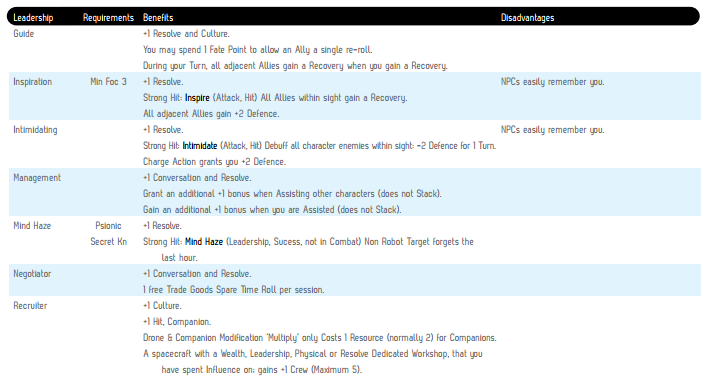
The joys of leadership.
Oh, it's also possible to play a robot or a psionic, which are really just traits that give you some tweaks on what your character can or can't do, and opens up access to special Traits. These work pretty much how you'd expect them to.
When you level up, you get a new Trait, and increase your max Resources and Influence by 1. You can also "Retro" and change one of your Traits, trained Skills, or Attribute points. The only real limitation is that you can't change a trained skill if you've bought a Trait for it, or change your Attributes in a way that would violate something's stat requirements.
The next chapter focuses on the Skills themselves, and this is where we learn the basic die-rolling mechanic in detail.
As stated before, using a skill is a base 3d6 roll, getting +1 if you're trained or -2 if you're not. You can get a +2 bonus or -2 penalty based on how you describe what you're trying to do (if you've got a 3+ in a relevant Attribute, then you can bring that into play for the +2 Description bonus but you still need to describe it).
Once you roll and add all your modifiers, then you compare that to a difficulty number. 8 is "easy", 12 is "average", and so on. If you beat the DC, then you do what you wanted to do. If you fail, you can try again, but at a cumulative -4 penalty for each attempt.
But here, as they say, is the twist. Any 6's you roll are called Strong Hits, and are the game's critting mechanic. Whenever you get a Strong Hit, you can "cash it in" for benefits. There are some combat-specific Strong Hit effects that I'll talk about when we get there, and your gear or Traits can give you other things you can buy. The one Strong Hit effect everyone has access to on every roll regardless of if it's a combat use or not is Effort. Effort lets you use a Strong Hit to reroll one of your other dice. So if you roll a 6-4-1, then you can use the Strong Hit to reroll the 1. And if that one comes up a 6, then you get another Strong Hit to spend.
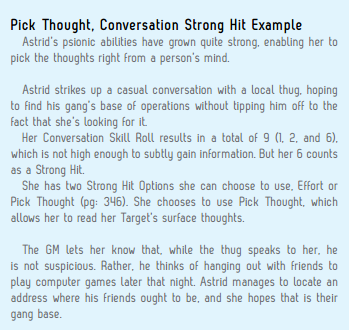
A example of using a Strong Hit, and a nice example of failing forward to boot.
Also, sometimes trying to use a skill will require special gear; you can't pick a lock without lockpicks. Every non-combat skill in the game has a type of toolbox or toolkit, and a Workshop. These are basically just things you need to perform more complex actions with said skill.
And yes, every skill. For instance, the Conversation skill can be used as-is to gather rumors, lie to someone, or get someone to answer a question. But if you have access to the Conversation toolbox (a suitcase of clothes and accessories) then you can do things like get a gang to help you by wearing their colors, put on a disguise, or make a good impression at a formal occasion. And if you have a Conversation Workshop (an event hall), then you can host a conference, hold a fancy party, or set the seeds for an alternate identity. Without access to the right tools for the job, you can't even roll in the first place.
Non-combat Skills have broad application. The Astronomy skill covers navigation, cosmology, stellar science, and gravitation, all of which are useful for getting around the galaxy. As long as you're trained in a skill, then you can do stuff related to those fields.
And again...a nice, clear, one-page summary. Why can't more games do this?
Combat and Vehicle System skills work a little differently, in that they just let you use weapons or systems that fall under that skill's purview. So the Small Arms skill covers pistols, SMGs, rifles, assault rifles, and shotguns. As long as you have the Small Arms skill you know how to use and maintain all that stuff. There are four Combat skills: Small Arms, Heavy Arms (grenades, explosives, mounted weapons), Tactical (using targeting systems and personal combat drones, as well as stealth), and Exotic (everything else, including melee weapons).
It's worth pointing out that one of the weapons listed under Tactical is "Your Mind". In this game your mind is a weapon.

That's about it for the skills chapter; really there's not a lot to really dig into because it's such a straightforward setup. It's a nice, easy-to-grasp deal which I appreciate.
The next chapter is Acquisitions, and covers how you get and maintain your equipment.
As stated before, getting (and keeping) stuff primarily revolves around three stats: Resources, Influence, and Spare Time. Resources and Influence are allocated to your various items or to your ship respectively, whereas Spare Time is spent. Your Resources/Influence are generally your level+2, but you can get boosts through Traits or as a reward from NPCs for doing missions for them. Likewise, you can lose Resources/Influence by screwing up badly, so it's possible to have a max Resources of 10 but only 7 available Resources due to some bad luck.
Resources are the simplest management method. Every piece of significant gear has a Resource cost, which you have to allocate from your Resource pool in order to keep it. This represents not just cash-on-hand, but items you can just go out and buy without a hassle. Resources also represent the upkeep of an item; guns need ammo, armor needs repairs, electronics need battery packs. At the end of a session, you can't have more gear "equipped" than you can handle with your max Resources.
quote:
For example, I have a character with 5 max Resources, and I've allocated two points to a "Little Friend" SMG, and two points to a set of Legion Assault Armor. I want to get a tactical computer, but that has a Resource cost of two. That means that if I want the computer, I either need to sell off one of the other items (since they'd be too expensive to maintain) or figure out a way to increase my max Resources.

Now, if I happen to be on a mission and kill someone who has a tactical computer, I can pick it up and use it for the rest of the session. But once things settle down, if I still can't afford to maintain it I can't keep using it.[/quote]
Now, I know you're looking at this and thinking "wait, so what can I do with the stuff I loot but can't use? That seems unfair." Well, when it comes to loot you have two options: just keep stuff aside and unused until you can afford the upkeep, or take everything and pack them into Trade Boxes.
Trade Boxes are a way of abstracting all the random loot and gear you find as you're out murderhoboing across the galaxy. So if you kill a bunch of mercs and now have a bunch of spare rifles and armor you don't need, you can pack those into a few crates and sell them down the line for a profit. The general rule of thumb is that you can turn 4 Weight of one type of "stuff" into 1 Trade Box. Trade Box items are generally kept broad ("guns", "food", etc.) or can be as specific as needed ("prefab colonization buildings", "untested biomatter"). Trade Boxes are stored in your ship and can be sold off with Spare Time rolls.
Anyway, that pretty much covers Resources.
Influence is very similar to Resources, only on a larger scale and with a few more systems in play. Influence represents your overall reputation or standing in various organizations. It's used for spaceship systems and maintence, and since the whole party is assumed to be using one ship it's possible for characters to pool Influence to get more expensive starship systems.
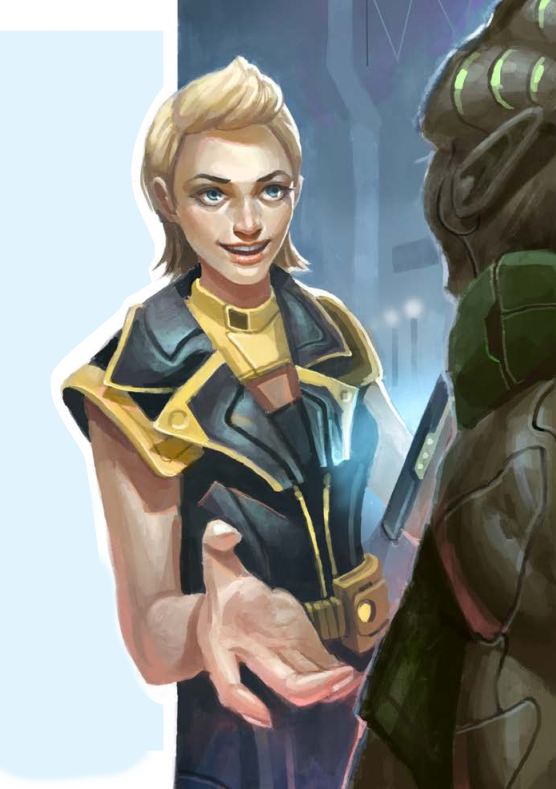
"Good news! I talked to my manager and he's willing to drop it down to only 120% interest!"
What makes Influence different from Resources is that, as your Influence grows, you'll get Perks and Complications.
Perks come in three "tiers", Minor, Moderate, and Major. You get Minor Perks at Influence 5, 10, and 20; Moderate at 15 and 25, and one Major at 30. Perks represent contacts, sidekicks, ranks in organizations, or extra storage spaces for trade goods (as in you own your own warehouse). Each type of perk can only be taken once, but you can upgrade a perk to the next tier. So if you have a Minor Contact, you can upgrade him to a Moderate Contact that's more useful, but you couldn't get two Minor Contacts.
Complications happen at Influence 9, 19, and 29. I discussed these before in character creation; they're ways to get more Fate points by having bad things happen to you. What's interesting is that Complications aren't things you really want because the mechanical penalty (such as getting -2 to all your social skills for any roll involving a race that is prejudiced against you) tends to outweigh the benefit. This isn't a Fate Core situation where you're using Complications as part of a dramatic back-and-forth, these are severe problems that bite you in the ass.
Now we come to Spare Time. Spare Time represents your ability to go out and, uh, spend time trying to perform more involved deals. Generally speaking, things bought with Spare Time are the kinds of things that don't need any form of maintenance and thus don't need to have Resources dedicated to them. Characters get one Spare Time point at the start of a session, and can gain more by looting small items (like jewelry and such).
Buying this kind of thing requires you to spend a Spare Time point and make a skill roll based on how you're trying to acquire the item. Spare Time costs are listed as " <number>t", which is the target number of the roll. If you fail the roll, you can try again; this doesn't get the -4 penalty but does require you to spend another Spare Time point.
For example, let's say I have three Spare Time points and want to get a headset (12t). I try to go buy one, but I'm not trained in the Wealth skill so I roll at -2. I fail the roll, but since I'm trained in Electronics I decide to build one instead. I roll my Electronics at +1 and spend my point, and this time I make the roll. I now have a working headset, but I'm down two Spare Time points. I probably should have just tried to make one to begin with but then this example wouldn't have been as good.
Spare Time points can be used for a bunch of other things such as modding your gear or paying for services (like medical treatment). Those will be covered later, but for now I'm just going to go over the two listed in this chapter: Trade Goods and Research.
Trade Goods are pretty straightforward. You can make Spare Time rolls to acquire Trade Boxes of goods, and also spend Spare Time to sell them. The thing is, you have to have a lot of goods to generate a profit: 12 Boxes of the same good net you 1 Resource, 16 boxes will get you 2 Resources. There are optional rules for different types of Trade Goods, such as dangerous goods that might damage your ship but sell for twice the price.
Research is how you can learn secret knowledge, develop new technologies, and gain Influence through your scientific discoveries.
You have Research a specific subject, such as "Legion codebreaking", "the structure of Geoff's crime family", "the lower lifeforms of Eris-7", or "that Mechonid doodad we found last week", and Researching does require a workshop or workstation of some sort. Performing research works like buying stuff: pick your skill, spend a Spare Time point, and make a 12t roll. Success nets you a Research point towards that subject. When you hit 12 and 16 points, you earn either a Minor Perk, or some sort of special knowledge as granted by the GM.
But that's not the best part: the best part is that you can actually publish your findings. If you choose to share your findings with an organization (scientific or otherwise), you can make a Spare Time roll to gain Influence points.
Yes, Fragged Empire may be the first sci-fi game where you can be a space-traveling murderhobo and be a published scientific author with a paper on the aquatic life of a planet with methane seas that you discovered when your ship got lost that one time. How fucking cool is that?
NEXT TIME: The building blocks of violence.
Combat
Original SA post
Part Three: Combat
So here we go. This is the part I'm sure people have been waiting to see: the combat system.
There are two different-yet-similar types of combat in Fragged Empire: personal scale and starship scale. The next two chapters cover personal combat, and the starship stuff will come later.
Basic combat is split into two chapters. The first chapter is the Combat Overview that covers the basics of combat (how to attack, how movement works, conditions, etc.), then the Combat Turns & Actions chapter that shows how all that stuff fits together in motion.
The Combat Overview chapter opens with a brief summary of how combat works, but is also very up front about the idea that combat is supposed to be rough:

Combat in FE takes place on a grid, with 1 square being 2 meters. On their turn, each character can take two actions, and actions consist of a Minor Effect and a Major Effect. These effects are the building blocks of the combat system, and the Overview chapter talks about the two primary ones: Move and Attack.
Move lets you move up to your Movement Attribute in squares. You can move diagonally at no extra cost, but moving through a friendly character or difficult terrain costs an extra point of Movement. That's...about all there is to it, really.
Next we learn about Environment, Conditions, & Effects. These are the things that tweak your other actions, but are stand-alone mechanical bits.
Interacting with environmental objects like doors or control panels costs 2 Movement. As stated difficult terrain requires 2 Movement to enter, and might require a skill roll as well. On top of that there's also dangerous terrain, which are environmental hazards that get to make attacks against you if you enter or start your turn in their space. You know, stuff like exposed wires, explosive barrels, or (my personal favorite) orbital bombardments. All of the example hazards have their own stat blocks, and are pretty much treated like a simplified NPC with only one attack. For example, an explosive object like a barrel or ammo crate has an effective defense of 10, and Energy based attack can cause it to explode, doing damage to everyone within 1d6 squares.
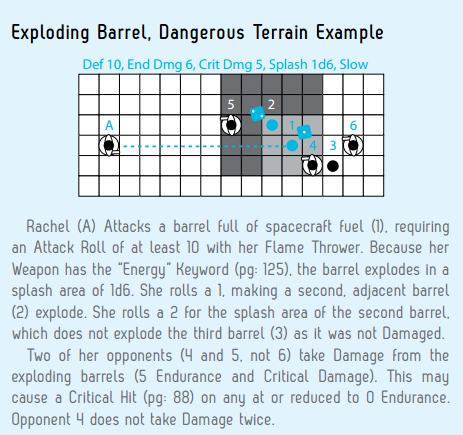
Remember: red barrels do not make good cover.
It's worth pointing out that the book has a ton of examples for everything. The section on special terrain alone has three very clear examples on how the mechanics work in motion. It's so nice to see an RPG book that both teaches you how to play and works well as a piece of reference material.
There's also a breif mention of moving through inhospitable environments outside of combat. For every two days you're going through a dangerous environment, you have to make skill rolls at difficulty 12. Failure means you get the "Worn Out" condition, and failing by 4 or more gets you the "Exhausted" condition. Going for two days without foor or water also requires rolls to deal with, but in this case even if you make the rolls the difficulty increases the longer you go without food or water.
Which leads us nicely into Conditions and Effects! I don't really need to explain what these are in a general sense; we've all played RPGs here.
Conditions in FE tend to be a bit more mechanically involved than they are in something like 4e or 13th Age. Some are simple (Blind means everyone gets +4 defense against you), some aren't as simple (Worn Out gives you -5 Endurance and -1 to Spare Time rolls for each Worn Out condition you have, but removing one removes all of them). For the most part Conditions need to be dealt through healing during downtime.
Effects are basically the same thing, only they're more straightforward and don't last as long. These are things like Prone (costs 2 Movement to stand/lay down, provides cover), Stealthed, Locked On (grants a bonus to attack, and can allow other weapon effects to trigger), stuff like that.
Now we come to making Attacks. Attacks are handled by skill rolls; 3d6+skill+ the weapon's Hit modifier - range penalties, with the target number being the target's defense.
Each weapon in the game has a Hit stat, which is a measure of its inherent accuracy. A pistol has a Hit of +1, a rifle has a Hit of 0, and a grenade has a Hit of -2. Likewise, each weapon has a Range stat; for every Range in squares you are away from your target, you get -2 to hit.
So let's say I've got a generic pistol (Hit +1, Range 3), I'm trained in Small Arms, and I'm shooting at someone 5 squares away. Trained gives me +2, +1 for the Hit on the weapon, but -2 because my target is more than one Range increment away. That's a total roll of 3d6+1.
Some weapons also have a Rate of Fire (RoF). When you take a combat Actions that grant you extra RoF, then you can spend extra ammo to roll an extra d6 for each RoF above 1. This is your spray fire, and you can use it to target multiple foes by splitting your die pool between them, adding your final modifier to each roll.
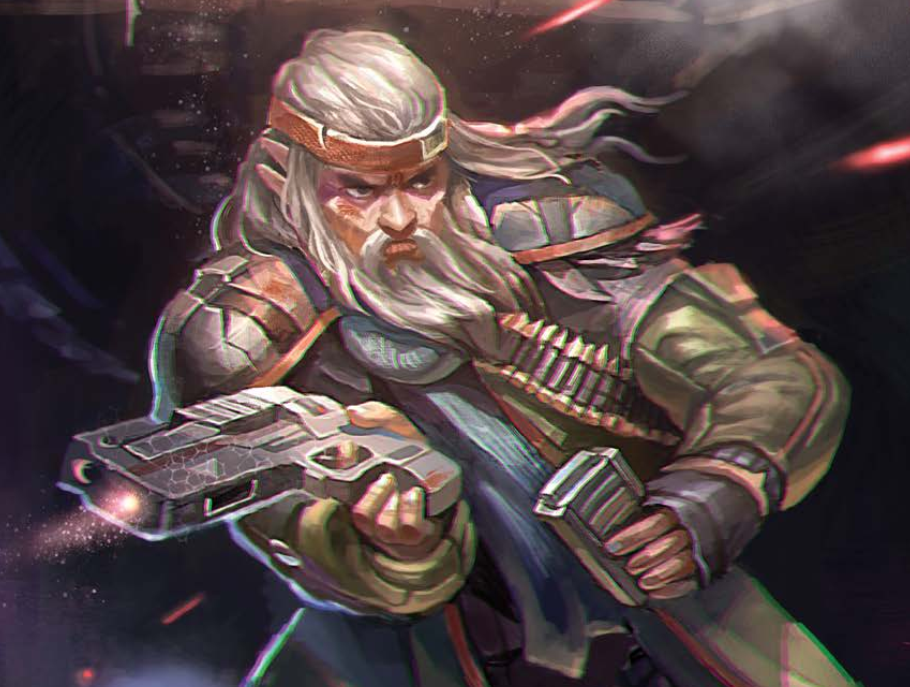
Getting those kids off your damn lawn...in the FUTURE!
In combat, Strong Hits get a few more cool things then can do. As always, you can "spend" 6's to reroll other dice, and weapons can have specific special effects that trigger on a Strong Hit. But the main use is to perform a Critical Hit, which we'll get to after we finish this and discuss Defense.
Defense (or "Defence"; the book uses the British spelling, which keeps throwing me off) is a calculated flat value. Your base defense is 10+Reflexes, plus any cover you've got. Armor doesn't increase your defense, but instead reduces damage you take from critical hits (which is the actual "killing you" damage).
There are also three special defenses for specific attack types: vs. Impair, Psionic, or Stealth. Each of these start at your base defense, but add your Strength, Focus, or Perception accordingly.
An interesting thing about Stealth: when you try to enter Stealth, instead of everyone constantly making rolls to notice you, you make an "attack" roll against the enemy with the highest Stealth defense, who gets +1 to his Stealth defense for every ally on his side. So if you're trying to sneak up on a guy with a Stealth Defense of 15 who has three friends, the target number is actually 18.
Cover comes in three categories: light (smoke, low light, the edge of a pillar) for +2 defense, heavy (Gears of War style chest-high-walls, total darkness) for +4, and entrenched (multiple sources of cover) for +6. Heavy cover and being entrenched also provide additional benefits against weapons with high RoF, or can make you immune to crits. Also, you can't go into Stealth unless you have at least light cover, so it's a pretty important mechanic.
And if this seems like a lot to remember, all this information is very nicely and handily included in the character sheet.
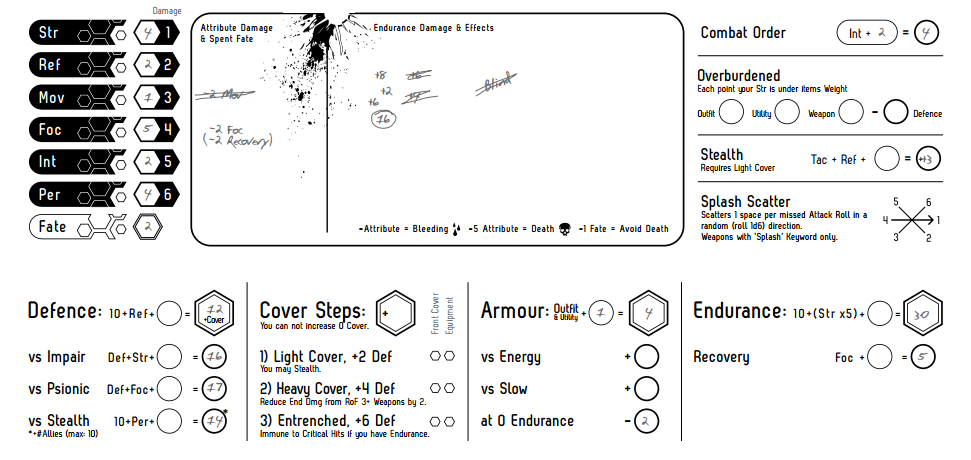
Because reference material is always useful.
At last we come to Damage. There are two types of damage: Endurance and Attribute. Endurance is equal to your (Str x 5)+10, and is basically your hit points. Normal attacks will come off this damage.
When an opponent spends a 6 for a Critical Hit, that's when you start taking Attribute Damage. When this happens, the weapon's Critical Damage, minus your Armor value, is done to one of your Attributes at random. This is why armor is important, and also why cover matters (being entrenched makes you immune to crits if your Endurance is above 0).
To make matters worse, if someone targets you with an damaging attack when you're at 0 Endurance, they can spend a 6 to get a Critical Boost: not only does the attack automatically crit even if you don't make the attack roll, it gets +1 critical damage.
If one of your Attributes goes below 0, then you start bleeding, taking 1 Attribute damage that ignores armor) to a random Attribute at the start of your turn until someone performs first aid on you with a difficulty 10 skill roll. If any of your stats reach -5 (or 0 for NPCs), then you die.
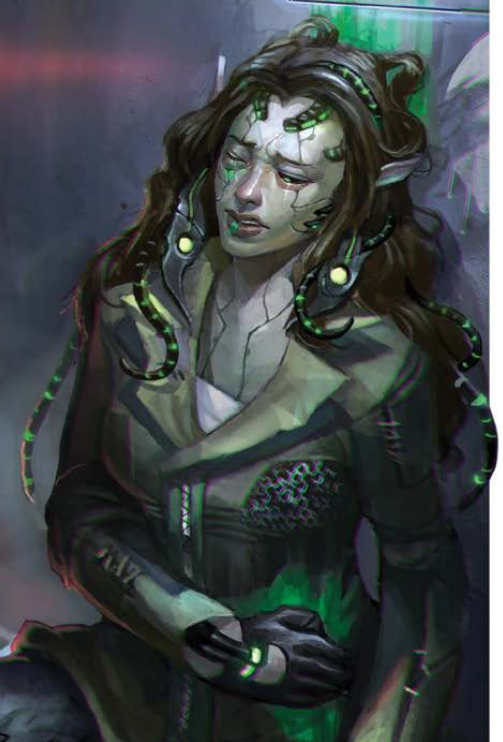
"My last request is that the Kaltorian doesn't get my share of the loot."
Healing is handled mainly through Spare Time rolls. You can do immediate after-combat healing with a Medicine roll of 12 or better, which will heal 3 Attribute damage taken in that fight. More involved healing require Spare Time rolls; you can undergo Extended Care to heal one point to all attributes and remove a minor condition, or Surgery to heal 8 points to one Attribute, remove one condition, and get a free Retro to swap an existing Trait for an Implant Trait if you feel like cybering up.
All that stuff needs to be done during Downtime, which takes place between sessions or adventures. When you're in Downtime, you heal all your Endurance, do all your Spare Time stuff, refill your ammo and replace gear if you have access to an armory, stuff like that.
The last part of this chapter are the Theater of the Mind combat rules, which don't use minis, a grid, or half the rules in the book. It's really more of an extended skill challenge, where everyone rolls attacks and such until one side gets a number of successes equal to the number of people on their side times two. It's more intended for less important fights, as a way of not having to bust out the minis when you're dealing with much weaker foes. I'm not really going to get into it because it doesn't really mesh with the rest of the stuff we're talking about here.

Not really relevant to the chapter, but I thought it was funny.
The next chapter is Combat Turns & Actions, and this is where we start putting everything together.
Initiative is handled in reverse Intelligence order, highest first. On your turn, you can perform any two Actions you have available. If one side gets the jump on the other, then they get a Surprise Round where everyone gets to take one Action.
There are 15 combat Actions all told, each of which has a Major and Minor effect.
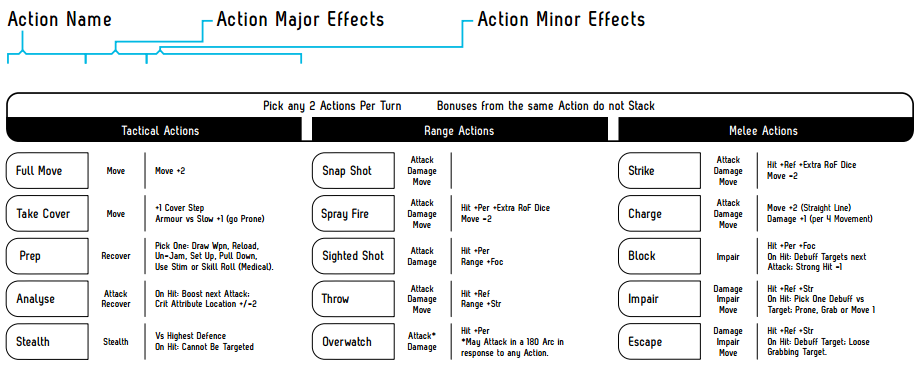
As seen here, which is also on the character sheet.
When you perform one of these actions, you do the listed Major effects in any order, as modified by the Minor effects. So taking the "Full Move" action just lets you perform the Move effect (major), but you get +2 spaces (minor effect). Taking a Sighted Shot means you can make an Attack roll, and if it succeeds you can do damage, but you get to add your Perception to your roll, and your weapon's Range is increased by your Focus.
You'll notice that some Actions will have Attack and Damage, or just Attack. That's because some items (like a targeting computer) are used via attack rolls, but don't do damage. If an action just has Attack, you can't use a weapon for that action.
We already know what Attack, Damage, and Move mean. The other three major effects are Impair, Recover, and Stealth. Impairment can affect an enemy's movement (grappling/knocking prone/shove 1 space), Recover lets you heal your Recovery stat in Endurance damage, and Stealth means you cannot be seen or targeted that round. Maintaining Stealth requires you to perform another Stealth action as your first action each round.
One side note: weapons have specific "types" that limit which actions you can take with them, but generally speaking it's all obvious stuff. You can't make ranged attacks without a gun, you can't do the Spray Fire action without a weapon with a Rate of Fire less than 2, you can't knock someone over with a pistol shot, stuff like that.
Let's look at one of the more complex Actions in closer detail. The Analyse Action has the Major effects of Attack and Recover, and the Minor effects "Hit +Per +Extra RoF Dice" and "On Hit: Boost next Attack; Crit Attribute Location +/-2". This action can only be done with a tactical computer or your mind. When I perform the Action, I recover (get back my Recovery in Endurance), and I can make an Attack roll with the Tactical skill against the target's Defense. I add my Perception to the roll, roll extra dice if I had a tactical weapon with a rate of fire, and if I hit I get a boost on the next attack roll I make: I can adjust the stat roll of a crit by up to two points in either direction.
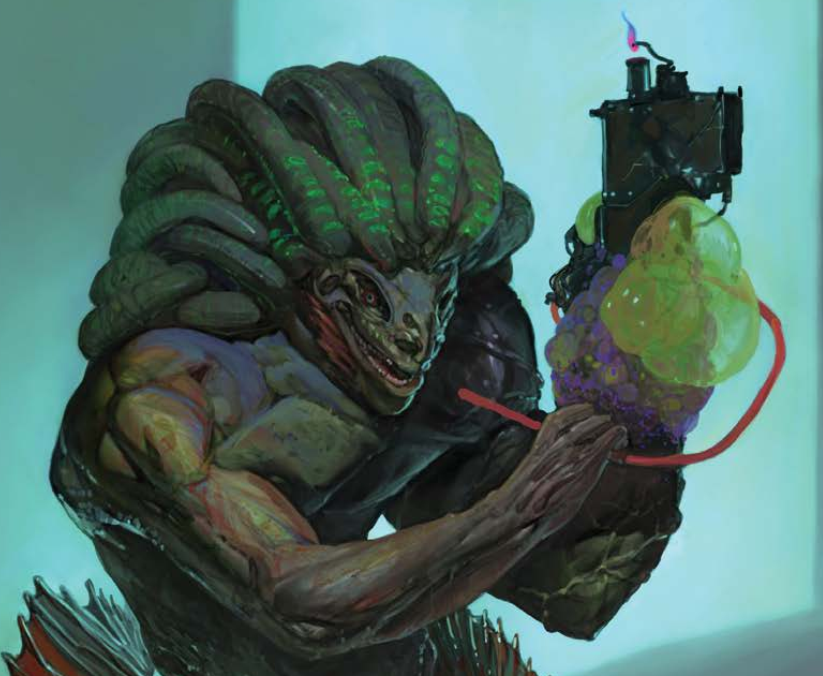
I call 'er "Vera".
The Overwatch action is a little different, in that you don't make the Attack roll when you perform your action. Instead, you pick a 180 degree arc from your character, and if an enemy performs an action in that zone, you get to make an attack as a free action after that character acts. So it's possible to get up in someone's face when they're overwatching before they have a chance to react.
Lastly, there's brief combat rules for Drones and Companions. Drones will be covered in more detail in the Equipment section, but basically if you have a drone or NPC under your command, then on your turn they can move and do one of the following: attack, reload, set up or pull down a heavy weapon, analyse, enter stealth, or attempt to escape from a grab. Drones and companions don't get the bonus riders that PCs do when they take actions, just the flat rolls.
And that sums up combat! I admit that when I first read this chapter it looked overly complicated, but that was because I didn't read the combat overview chapter in full. Fragged Empire is written in a way that is designed to build up; it starts you out with the basic building blocks (here's how to attack, here's how defense works, here's how you take damage), then takes those concepts and builds them up to the more complex ideas (combining attack/move/etc. into actual combat actions). Once you know how to read the actions list, it's easy to see what your options are and what they do. The short list of actions
I also like the focus on movement and cover in combat. Cover especially; it's nice how it does more than just +X to defense, and I like how it ties into the stealth mechanics. Likewise moving around to flank or get to cover keeps things dynamic, which is always important in a minis game. As much as I liked 4e, there were points where a lot of times there'd be little to no movement because everyone was engaged with someone else and had to reason to move, or would have to worry about opportunity attacks if they did. Here, getting to good cover or keeping moving to reposition are equally valid strategies.
But that's enough violence for one day. We've covered fighting, and soon we'll talk about the things to fight with...
NEXT TIME: There are many like it but this one is mine.
Equipment
Original SA post
Part Four: Equipment
Let's be honest here; regardless of what it's about, a sci-fi game can live or die on its gear. And the problem with that is that it's very easy to wind up with the classic list of hundreds of weapons and armor and such, each of which only differs from the others by a point or two. It can also lead to the "best gun" problem that was discussed upthread, where there's always one or two guns that are objectively better than all the others, so everyone uses them, leaving most of the equipment list untouched.
So how does Fragged Empire deal with these potential problems?
Equipment falls into three categories: weapons, outfits (armor), and miscellaneous items. Miscellaneous items are just that; the stuff you buy via Resources or Spare Time rolls and you're set. There's a page-long list of stuff to buy, like communication headsets or tablet computers or backpacks and whatnot.
Weapons and outfits, however, are handled in a more general fashion. Instead of providing a long list of twenty slightly different pistols, then a list of two dozen slightly different rifles, and so on, FE provides generic weapon and outfit types, then allows the player to customize them in a few different ways.
Weapons fall into four broad categories that line up with the weapon skills: Small Arms, Heavy Arms, Tactical, and Exotic. Each weapon has a short list of generic weapon types; for instance there are only five types of small arms: pistols, SMGs, rifles, assault rifles, and shotguns.
Here's the stat line for a base rifle:

And here's the stats for a chemical thrower:

We've talked about a few of these numbers already, but to summarize:
- Hit is the bonus to your attack roll.
- End Dmg is how much Endurance damage the weapon does on a normal hit.
- Crit is how much Attribute damage the weapon does on a critical hit.
- Rng is the range increment; for every Rng squares between you and the target, you get -2 to hit.
- Clips is how many reloads you get with the gun. You can buy more, of course, but this is the "default" number of extra clips you get.
- Ammo is how many shots you have per clip. Ammo is generally based off a gun's RoF, so if you increase a gun's RoF then the gun's ammo is automatically increased to take that into account.
- Load is how many item slots the weapon takes up once we get to the inventory system.
- RoF is the maximum number of shots you can make per action; each shot after the base first gives +1d6 to your attack roll. Each shot you use up to a weapon's RoF costs one ammo.
- Wgt is the weight of the weapon.
- Weapon Type lists keywords that tie into the weapon modification system.
- Cost is how many Resource Points the item requires, or what the Spare Time roll is to aquire it. Some items do require both: the Spare Time roll to get the weapon, and the Resource cost to maintain it.
The chemical thrower is Slow (does nothing on its own, but is a keyword that can trigger other stuff), Jam 1-5 (the weapon will jam on rolled triple values of 1-5), targets get -1 Cover step against attacks with this weapon, and if you make a Spread Fire attack then you get +1d6 to each attack roll.
Once you have your base weapon, you can adjust its numbers and/or add on new capabilities through the use of Variations and Modifications.
Variations are changes that affect the fundamental style of the weapon, such as turning a normal pistol into a gauss pistol or installing a chem injector into a sword. Variations also come in different categories ("gun variations", "chemical variations", "melee shape variations", etc.) that determine what variations can be put on which weapons, but a weapon can only have one variation per category. So you can turn a generic pistol into a gauss pistol (+1 RoF, but can jam) or a bio-tech spine launcher (lower ammo and Crit, but higher End Dmg and RoF), but you can't have both traits on the weapon.
Modifications, on the other hand, are only limited by your ability to pay for them. These are things like targeting scopes, tripods, extra clips, and so on.
By way of example, let's trick out a rifle. I start with the standard rifle above, and I have the option of adding one Gun Variation and one Gun Size Variation. For the Gun Variation, I'll take "Self-Propelled"; this increases the Range stat by 1, and adds the "Low Tech" and "Works in Liquid" traits. There's only three Gun Size Variations (Body Mounted, Mounted Weapon, and Tiny) so I won't take any of those.
For mods, I'm going to add a Laser Sight (+1 hit), a Targeting Matrix (adds +2 to hit if the target is Locked On, loses Low Tech), a Tripod (+1 Weight, halves range penalties while deployed and shooter is prone), and a spare clip (obvious).
Now I look at the costs of all this. The Gun Variation has a cost of +0, so that doesn't affect the cost of the rifle. The modifications all have separate Spare Time costs, generally 12t or 14t.
And just for fun, let's add a grenade launcher onto the rifle. Grenades are "Shell, Thrown", which means it can be either fired from a launcher or thrown by hand. Grenades have the following stat line:

Again, I can add one Shell Variation and one Gun Size Variation. For the Shell Variation, I'll make them shrapnel grenades; +2 End Dmg, -1 Crit Dmg, +1 Splash radius, and Low-Tech. For the Gun Size, I'll take "Mounted Weapon". That gives -1 to End Dmg, Crit, Rng, and Clips, but turns the grenade into an item that's attached to another weapon, granting me the Strong Hit option Combo Strike: if my rifle attack hits, I can make a free attack with the grenade launcher at the same target with -2 to hit.
The final stats of my custom rifle are:
quote:
Rifle With Underslung Grenade Launcher
Hit -1 End Dmg 3, Crit 4, Rng 6, Clips 3, Ammo RoF x4, Load 2, RoF 1*, Wgt 4, Weapon Type Gun, Cost 3
*Strong Hit (5-6) with all RoF 1 Attack Rolls, Works in Liquid Laser Sight, Targeting Matrix (+2 when Locked On), Tripod (Set Up 2, Pull Down 1, Arc of Fire 45, *Half Range Penalties while Prone with Sighted Shot Action)
Shrapnel Grenade Launcher
Hit -2, End Dmg 7, Crit 3, Rng 1, Clips 1, Ammo RoF x1, Load 1, RoF 1, Wgt 0, Weapon Type Launcher, Cost 1
Splash 3, Small, Slow, Low-Tech, Strong Hit: Combo Strike (Hit) Make a free Attack with Main Weapon at the same Target with Hit -2
(It's interesting to point out that one of the listed melee weapons is a metal chair, which means it can be modified as per normal rules. So your character could have a pair of retractable, biotech, fightin' chairs balanced for dual wielding and covered in nano-bone spurs. Whether you think that's a bug or a feature is, of course, entirely up to you.)
Two interesting weapons on the Exotic weapons list are actually pets: the Legion Hound and the Nephilim Beast. They're stand-alone NPCs, but it's worth noting that while the Hound can't be modded, the Nephilim Beast can, so you can give it all kinds of fun biocyber add-ons. Yikes.
If you really want to go nuts with weapon modifications, you can make a Prototype Weapon. Prototype weapons require some sort of Secret Knowledge to aquire (so start researching), not to mention a good outlay of Resources. But the upside is that you can now pick options off special "Prototype weapon variation" lists.

A few examples
One tactical weapon I haven't really gotten into are drones. Drones are basically autonomous weapons you can control during a combat. I touched on these briefly in the Combat chapter, but the short version is that they're mini-NPCs that can follow basic instructions, but are generally used to provide fire support. They're considered Tactical weapons, and have their own stat blocks. They can also be tweaked out in various ways as per the normal weapon rules.
The book also provides a bunch of pre-made "common" weapons, so you can get something effective without having to dig into the customization system.

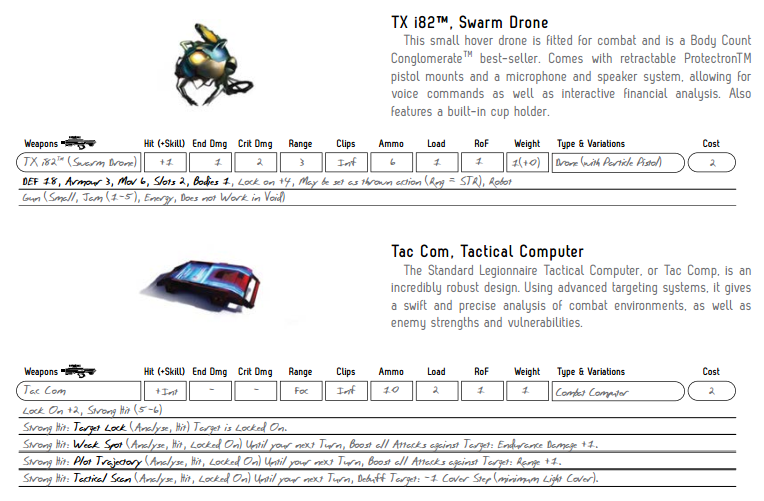
Outfits and their related modifications work like weapons; you pick a base piece, add one variation and as many modifications as you want. Outfits also have a few stats:
- Armor is the flat reduction of Attribute damage.
- Defense is is added to your Defense value.
- Endurance adds to your Endurance value.
- +Cover provides free steps of Cover when you're actually in cover. This is mainly for your Stealth suits.
- Front Cover grants you a bonus to attacks made from a 90 degree arc in front of you. This is one of the few times facing matters in the game.
- Slots is how much inventory space the outfit gives you.
- Weight is the minimum Str needed to use the armor effectively. If your Str is below the outfit's weight, you're overburndened and suffer a Defense penalty.
- Cost is the maximum number of shots you can make per action; each shot after the first gives +1d6 to your attack roll. Each shot you use up to a weapon's RoF costs one ammo.
One of your base outfit options is "Clothing", which provides no armor but gives a +1 to Conservation rolls. However, you can take normal clothing and add things like Shield Nodes (provides an energy shield), an Auto-Med system (can use a stimpack as a free action), a Tactical System (built-in comms), and make it Personalized (takes up less inventory space just for me, takes up more and weighs more for anyone else). Now you've got a nice three-piece suit with some defensive capabilities.
It's important to note that there's no real way to increase an Outfit's inherent armor bonus. If you want decent armor, you need to pick an outfit with decent armor out of the gate. Which makes sense; that way you don't have to worry about people taking a suit of clothing and slapping armor mods onto it until their coveralls are as good as a full suit of tactical armor.
And once again, there's a bunch of sample outfits to work with.
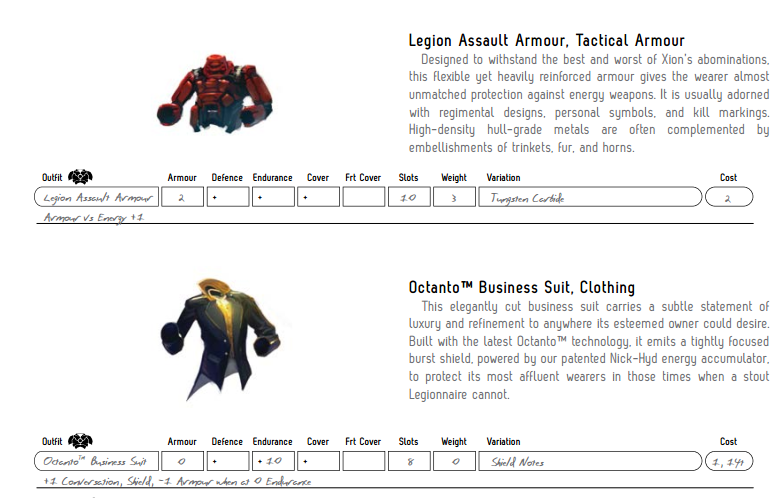
Next, there's Utility Items. Utility Items are your special pieces of gear that serve a specific purpose. You can only have one Utility Item equipped at a time, but that's because they're involved pieces of hardware. These are things like drone control modules, stealth nets, a high-end targeting system, and so on. These items are straightforward off-the-rack stuff that can't be modded.
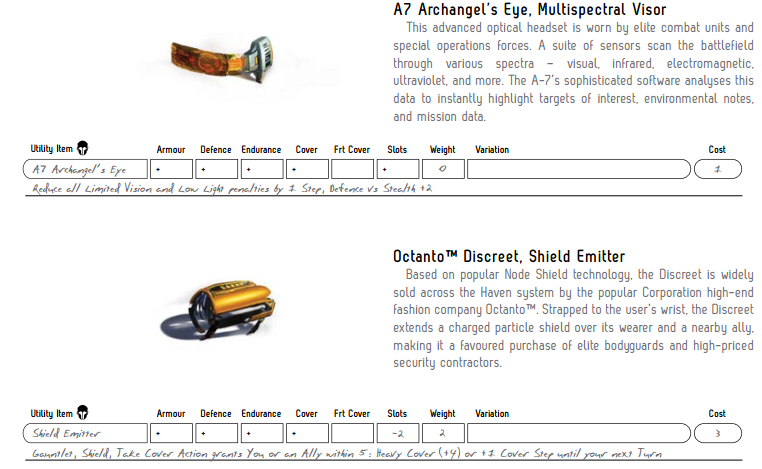
Last up are Miscellaneous Items. This is pretty much the "everything else" category; flashlights, headsets, medical supplies, etc. One important item to point out here is the alcoholic energy drink Draz. Draz is a Corp-made superdrink that costs 14t and removes your need to sleep for one night, granting you a Spare Time Point. It can also be cooked up into an addictive meth-like drug that will grant temporary Armor for a few rounds, after which it deals unavoidable damage to one of your physical attributes that can't be healed without substantial medical work. Oh, and it's addictive as hell, too.
All this now begs the question "how much of this crap can I drag around?". The way inventory works in FE is that you have a number of Equipment slots based on your Outfit, Utility Items, and Traits. Each non-Outfit item takes up an number of slots equal to its Weight. Your Outfit (and possibly Utility Item) will determine how many slots you have. Weight 1 items can be used one-handed, Weight 2+ items require two hands to use.
And that's really it. It's an interesting take on the whole "gear porn" concept because instead of giving you two dozen pages of items, of which only maybe ten items will see real use, players can tweak their gear to their personal needs. It's not complicated outside of there being a bunch of options to choose from, but at least it's a front-loaded difficulty. Once the item's built, you're set. The one thing I wish they had was a spreadsheet you could just pick options from to do the math for you, just for ease of use. I'm sure it'd be relatively easy to do for people who speak Excel.
We're going to cover starships next, and unsurprisingly we're going to see some interesting similarities to the equipment section.
NEXT TIME: To infinity and beyond.
Starships and Starship Combat
Original SA post
Part Five: Starships and Starship Combat
So, starships. As you'd imagine for a game based around sandboxing throught the galaxy, starships are a pretty important thing. And in keeping with how gear is handled, starships can be custom-designed to the players' specificiations based on what they can afford.
Starships are are stated up in a manner similar to PCs; they have stats, traits, gear, and perks. Most of these require the group to pay out in Influence to represent the standard maintenance needed to keep the ship flying. Since starships are used by the whole party, all the players can combine their Influence into a single pool to build the ship. However, if the group's total Influence falls below what's needed for the ship, then the ship's weapons and traits will be lost in various was (breakdowns, no ammo, etc.) until the PCs can get the minimum cash flow going again.
It's worth noting that the group doesn't need to have just one ship. It's possible to break the total Influence into multiple pools to maintain multiple ships, so if you want one guy to have a single-man fighter while everyone else tools around in a cargo hauler, that's perfectly fine.
The first step in making a ship is to assign its Attributes. There are six Attributes for ships:
- Hull represents the overall size of the ship. This determines how much Cargo space you have, and what kinds of weapons you can slap onto the thing.
- Engines determines your accelleration/decelertation speed.
- Crew is the quality and quantity of the ship's crew (if you have NPC crw), as well as how accessable the ship's systems are for the people on board.
- Power is your ship's generator output. This is used for shields and boosting systems.
- CPU is the power of the ship's main computer. This is for intiative and Locking On to targets.
- Sensors are what it says on the label. Used for long-range attacks.
Ships also have a "Size" Attribute, which goes from 1 to 5 and defaults to 3. A Size of 1 is your standard-issue single pilot fighter, a 3 is your Firefly-class "we all live here" ship, and a 5 means you're dealing with a battleship-sized deal. Size can be changed later when you buy Traits.
Once you do all that, then you figure your ship's base and calculated values:
- Cargo space is (Size x 4) + Hull - 10. This is how many slots you have for Trade Goods or Workshops.
- Weapon Slots is the same as its Size. Each weapon you install on a ship takes up a number of slots.
- Resupply is the Size x 2. This is how many days a ship can travel before needing refueling and restocking.
- Defense is 12 - Size + Engines.
- Armor defaults to 3, regardless of Ship size.
- Shields is 10 + (Power * Size).
Next, you pick the ship's Build, which (in a manner of speaking) is the ship's species. Or at least, which species built the ship. This will adjust the ship's Attributes in various ways; a Corporation-built ship will have more Cargo space, slightly better Defense, and an extra Perk; but it'll also have lower max Attributes and a penalty to some repair rolls. Meanwhile, a Legion ship will improve one Weapon and is more resistant to ongoing damage, but has less Cargo, -1 to its CPU, and has one less Perk.
Next up, you can pick one Trait per Attribute, including one Size Trait, at the cost of 5 Influence each. These work like PC Traits; they can modify your ship's stats, give you mechanical benefits, things like that. And there are some pretty neat options here; you can take the ever-popular Hunk of Junk Hull Trait, which reduces the ship's Influence cost by 10 and gives you +1 point of Secret Cargo space, but lowers your ship's stats. You can attach Solar Sails to your Engine stat, which increases you're ship's turning speed if you're near a sun. Things like that.
Size Perks are straight modifiers to the ship's Size (duh), which will also modify the base stats of the ship. Making a ship a Heavy Fighter is -2 Size, but makes your ship harder to hit, for example.
Now you can start jamming Weapons onto your ship, and again these work like they do for PCs. Ships have a base number of slots for weapons equal to its size (modified by Traits or Perks, of course). Like PC weapons, ship weapons fall into general categories: Command (boarding parties and special squads), Operations (missiles/rockets/mines), and Gunnery (general guns and artillery). You pick a base weapon type, add a Variation and as many Modifications on there as you can afford. You don't have as many options here as you do with personal gear, but you can still make some rather fun things like an acid-spewing point defense system or launchers that inject drone swarms into enemy ships if they can breach the hull.
Of particular note are "Warhead" type weapons, which are not instant fire-and-forgets but are actual drone-like objects that get a figure on the map and will move each round until they hit their target or are shot down. It's a nice twist on normal combat that adds an extra dimension to things. Fighters and teams of boarding troops are available as well, and are again treated in a manner similar to drones.
It's important to note that weapon placement matters. Some weapons are considered "batteries", which mean they have a 90 degree arc of fire based on what side of the ship they're on. "Ordinance" like missiles can only be launched from the side of a ship, but after that can move and attack independently.
Lastly, you can pick Perks. There are two kinds of Perks: automatic and optional. Every ship starts with all the automatic perks, which cover the basic functions of the ship. They're listed as Perks because some ship Traits can reduce the number of automatic Perks your ship has ("By the way, the ship doesn't have life support or docking clamps. Is that a problem?").
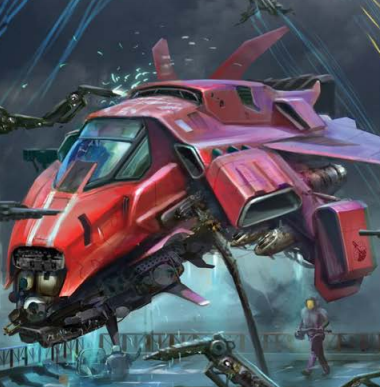
A typical size 2 ship.
The optional Perks are just small tweaks to your ship's stats, like more storage space, extra rooms, or a small shuttle. You can have as many optional Perks as your ship's Size.
Outside of combat, ships can travel from planet to planet within a star system through the use of standard-issue jump drives, and can move from galactic sector to galactic sector through the use of spacial rift things called ley lines.
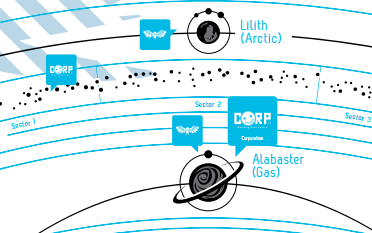
When you look at the system map, you'll see blue lines on the map between the various planets. For each of these lines you cross, that counts as one day of travel. So here, it'd take five days to get from Alabaster to Lilith.
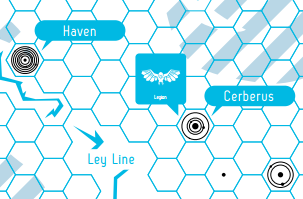
On sector maps, everything is broken down into hexes. Moving from one hex to another is considered six days of travel. But here's the thing: the parts of the map with ley lines count as one single hex. So on this map, if you travelled from Haven to Cerberus without using the ley line, that'd be six hexes times 6, or 36 days of travel. But if you took the ley lines, then you'd only be passing through four "hexes", so you'd only need 24 days.
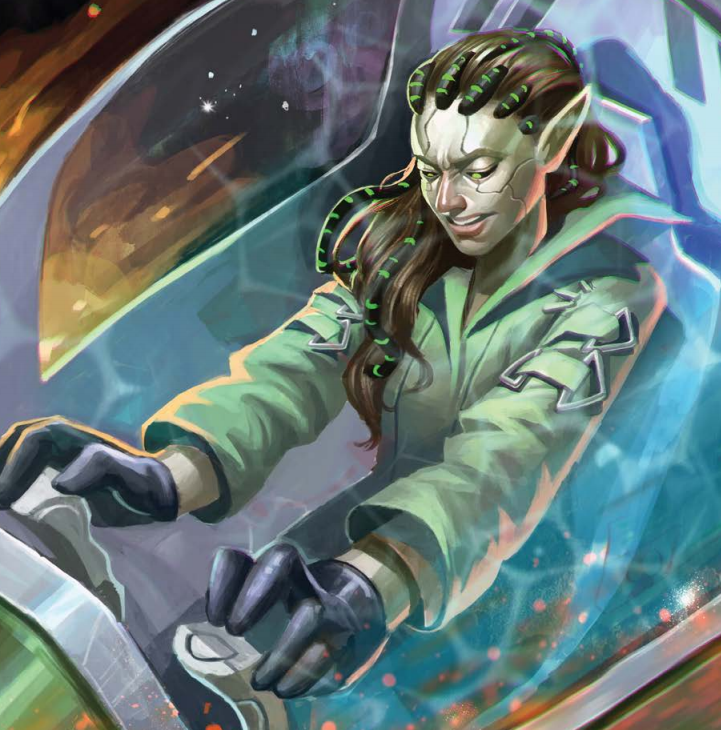
"Dammit, why does he always leave the seat so far back?"
Now we come to Starship combat. Starship combat works on a grid like personal combat, but has a few significant differences.
For one, starship combat can scale up or down as needed. What determines the scale isn't the size of the ships involved, but the speed the ships are moving at. When things are "pulled in", the assumption is that ships will be moving relatively slowly around each other; this is probably what you think of when you picture "spaceship combat". When ships are intended to be moving faster (such as a chase through a system), then the scale is pulled out to reflect the greater movement. It's even possible for the scale of a combat to change as the people involved increase or decrease by hitting a certain speed for so many turns.
One of the core concepts of starship combat is Velocity. Velocity represents both your ship's speed and your initiative. It goes from 1 to 6, and the game suggests putting a d6 next to your ship's mini to track it. Ships act in reverse Velocity order (i.e., fastest to slowest), with ties going to the larger ship.
At the start of your turn before you do anything else, your ship automatically moves forward a number of spaces equal to its Velocity. Facing matters in starship combat, and you can only turn in 45 degree increments as part of your normal actions. On the plus side, since space is pretty empty you can't accidentally collide with objects when you move; if you finish your movement on another ship, you just have to move to an adjacent space. There are some types of special environments that you can use in spaceship combat (dust clouds, nebulas, asteroids, gravity fields you can use to slingshot yourself), but in the interest of brevity I'm not going to get into them here.
Attacking and defense work fairly similar to personal combat; you make Attack rolls with appropriate skills, and Defenses reduce damage. There's no cover in space (of course), but some environmental effects will reduce an attacker's roll. PC Ships are destroyed when any of their stats reach -5, and NPC ships are destroyed when a stat hits 0. Unless the ship has a perk like Escape Pods, when a ship is destroyed everyone on board is killed.
Unlike personal combat, though, spaceship combat involves a crew of people controlling one "character". This is handled through System Rolls, and this is where things get a little complicated. Each turn, every character on a ship can make one of two types of System Rolls: a Command roll to control the ship's movement, or a Secondary roll to do pretty much everything else. Each character on a ship gets to make one roll of either type per round, and each action that's taken can only be succeeded once per round (barring special Traits). So if one person successfully makes a Full Burn roll on his action, someone else can't attempt it again until the next turn. But if the first person fails the roll, then someone else can attempt the action.
Command System Rolls happen first and are resolved for every ship before any other types of System rolls. There are four options for a Command roll, each of which requires hitting a certain difficulty: Full Burn (diff 8) lets you rotate the ship 45 degrees and adjust your Velocity up for down by the ship's Engine stat; Maneuver (diff Size x 4) lets you rotate 90 degrees and adjust Velocity by Engines-2; Direct Crew (14 - Crew) lets you rotate, improves your armor against Boarding attacks, and lets someone else make a free Secondary System Roll or launch a fighter; and Strafe (Size 1 and 2 ships only, diff is the target's Defense) lets you rotate your ship and attack at the same time.
Once each ship has performed their Command System Rolls, things move to the Support System Rolls, a.k.a. "what everyone else gets to do". The non-pilot PCs aren't just sitting around during dogfights; they're expected to be manning weapons systems, spraying fire extinguishers on fires in engineering, repelling boarding crews, things like that.
Ships act in highest-to-lowest order based on their CPU stat. Each PC can make one type of roll: Engineering (for repairs), Operations (for support actions or controlling missiles), and Gunnery (firing things at other things). Each roll type has four possible things you can do, and again each on has a specific difficulty. For example, the "Divert Power" Engineering action has a difficulty of (14 - Pow stat), and if successful will give another System roll a free Strong Hit, but reduces shields by 5. The Operations action "Dumb Fire" will launch a Warhead that will attack (vs. Def), but instead of following its target will blow up at the end of the round if it misses. The Gunnery action "Volley" lets you attack with a weapons battery, getting +1 Shield damage.
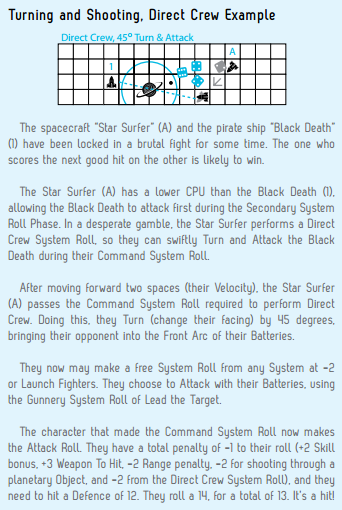
The last chapter on starships is a breakdown of the various weapon types. Fighters are effectively the same as personal drones, only on a larger scale. The main new concept here are how Boarding Parties work.
Boarding Parties are treated as an abstract condition on the ship, and can be stacked up to five times. Boarding attacks are generally delivered via docked ships or special types of weapons. At the start of a ship's turn, every boarding party on that ship gets to make an Attack roll, not only as a free action but against an effective armor of 0. If the attack fails, though, then the boarding party is killed and you remove one level of the effect. And of course there are traits you can put on your ship (such as crew) that will help defend against boarders.
I know that sounds odd ("why can't people inside the ship fight back?"), but the idea is to keep things simple so you don't have to try and have two simultaneous combats with different scales going on at the same time. Which I get; but it's still a little too abstract. I think the idea is that boarding parties aren't the kinds of things you deal with a lot, or at least not in detail at the same time as a big fight's going on. Like, you can't man the guns and have a hallway shootout at the same time.
Overall the starship combat is interesting, but in all honesty I found it the only real confusing part of the whole system. I feel like it's one of those situations where things have shifted just far enough from how the rest of the game works that it feels more different than it should. Fortunately, the game is very up-front about how the starship stuff is completely optional; in addition to theater-of-the-mind rules that boil down to just making rolls until one side gets X more successes first, there's also a "No Starship Combat" option that reduces things even further down to just "whoever succeeds first, wins". And really, the nice thing about the fact that the starship systems aren't tied closely to the rest of things is that you can just flat-out not use them at all without worrying about breaking anything. No skills become irrelevant; at most some Traits aren't needed anymore. It's nice to know that you can skip this part of the book and not worry about some skills becoming trap choices.
And with that, we're mostly done with the mechanics, or at least we're done with the player-facing mechanics. There's some GM-facing stuff that we'll get to in a few chapters' time, but before then it's time to start digging into the setting itself.
NEXT TIME: The major galactic players.
The Haven Races, Part 1
Original SA post
Part Six: The Haven Races, Part 1
Now it's time to get to the stuff I think most of y'all were really interested in: the setting. And before I get too deep into this, I am going to point out something important: a lot of what I'm going to talk about here in terms of history is conjecture based on what's said in the book in regards to other things, or by reading between the lines of the current state of the setting. Fragged Empire is a setting that's about looking forward more than looking back; the past is there to be mined for lost knowledge, but for the most part the galaxy considers humanity to be an ancient legend, and the general attitude towards the Archons and X'ion can best be summed up with "and good ridance".
Things start out with a little more info on the overall setting timeline. To hit the major points:
It's over 10,000 years from now.
Humanity has been extinct for most of those 10,000 years. We reached a point of cultural and technological stagnation, as well as genetic erosion, after expanding throughout the galaxy. While we were still around, however, we created two very important things that would affect the universe for millennia to come: the ley lines, the cracks in space that allow for FTL travel, and out genetic "replacements", the Archons.
Before humanity died out, we also created a galaxy-wide distributed computer network called the Palantor Network. Humans copied their minds into this virual paradise so they could live on after a fashion.
The Archons inherited the galaxy from humanity. However, instead of focusing on advancement through what we normally think of as technology (i.e., electronics, computers, etc.), the Archons chose to focus on genetic engineering.
For the next few millennia, the Archons created and seeded the galaxy with new intelligent species. Some as experiments (such as the Vargati), some as tools (the energy-manipulating Twilinger, who'd later become the Twi-Faren), and some as "pets" (the Kaltorans). Every new species was a step towards the Archons' overarching goal: the creation of a "perfect species" as proof of their mastery over life itself.
The Archons thought they achieved their goal with the creation of the twelve X'ion. Unfortunately, the reasons why the Archons turned on their creation have been lost to history. What is known is that the Archons attempted to destroy the twelve X'ion, but only succeeded in killing eleven of them. The remaining X'ion survivor managed to escape into deep space.
Two hundred years later X'ion returned with its own genetically engineered race: the Nephilim. X'ion wanted revenge on the Archons, and began attacking every living thing in the galaxy. In a rush to defend themselves, the Archons created the soldier race known as the Legion.
As the Legion became overwhelmed, the Archons attempted to access ancient human robotics technology in a last-ditch attempt to stop X'ion. They pulled what they thought were long-forgotten AI programs out of the Palantor Network and jammed them into warbot bodies, creating the Mechonids. The once-human minds were driven insane by this sudden "attack" of being pulled out of a digital paradise and jammed into poorly-understood positronic brains in warbot bodies to go kill things, and as a result the Mechonids also turned on their creators. Oh, and they wanted to wipe out all other organic life, too.
Within six years, the Archons were rendered completely extinct by X'ion's forces.
Its work done, X'ion returned to deep space, leaving the Nephilim behind.
One hundred years of "peace" followed. Although, technically, it's only really "peace" because nobody was really able to fight; nowadays it's refered to the "Years of Darkness" due to the surviving species being cut off from...well, everything. The Legion's commanders were dead. The Nephilim's creator had abandoned them. The Kaltorans, once the Archon's favorite race, were almost wiped out entirely due to their favored status. None of the races left behind had the desire or the technology to continue the war, so for the next century the various races crawled out of the rubble, looked around, and started to rebuild. It would be the better part of a century before the various races rediscovered interplanetary travel and began to meet up. Tenuous alliances were formed between former enemies for mutual survival.
Five years ago, a formal alliance between the Vargati (now calling themselves the Corporation), the Kaltorans, the Legion, and the Nephilim was created. Focused around the Haven star system, all the remnants of the Archons and X'ion gather together and try to figure out what comes next.
Which is where we are now.
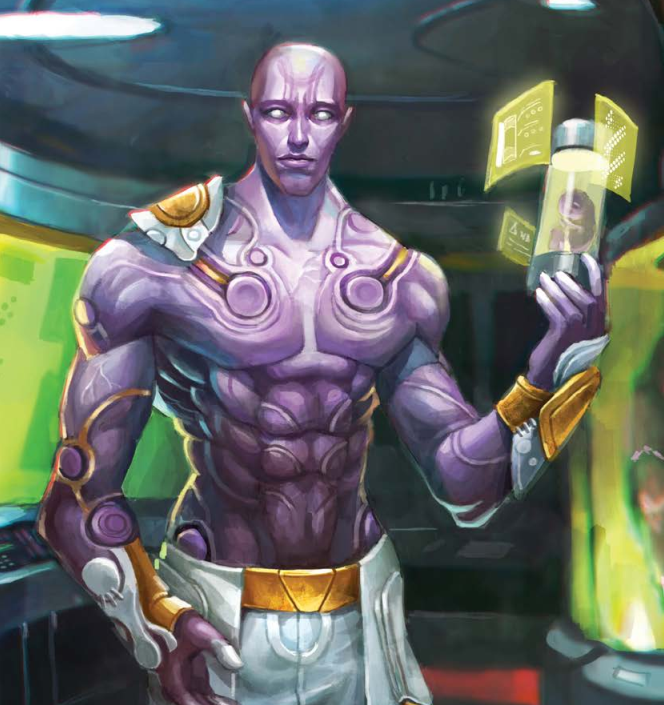
An Archon
As stated previously, the four races presented in the core book are the largest power blocs in the galaxy. Not because of numbers, but because of what they've brought to the table, and also because they happened to get to said table first. They're collectively referred to as the "Haven races", and while they're all allied with each other there's really no central governing body just yet. That's not to say there's no overarching bureaucracy yet; in the Protagonist Archive there's a piece of fiction involving the new races petitioning an immigration board (consisting of a member of each of the Haven races) for permission to settle in the Haven system. That said, ultimately a galactic government is still a ways away, mainly because long-distance trans-system communication doesn't quite exist yet. Or, more accurately, hasn't been rediscovered.
Which brings us to a little side-track in regards to the technology of the setting. As we've seen, even though the Archons didn't really care about the technological side of things, the Haven races still have access to a very high-tech infrastructure. While an extinction-level "apocalyptic" event did happen, there's still mass production, computer networks, and the ability to perform advanced cyber implant surgery. That said, while there's general access to all this stuff, there's still a lot of technology that's been lost, or that is just flat-out not understood at all. The Archons had no interest in developing new technologies that weren't related to genetic manipulation, so they just used the stuff the humans left behind without worrying too much about how it worked as long as it did.
So there's still well-maintained computer networks and manufacturing plants, as well as manuals and instructions teaching people how to create new stuff. People aren't scrounging to make guns out of spare parts or Frankensteining spaceships together. Genetic and cybernetic implants aren't exactly commonplace, but the tech level is high enough that they're possible. But at the same time, there's still a lot of gaps in the technological understanding. For instance, nobody's been able to crack how to make a galaxy-wide communication network yet. Or figured out how the Ley Lines were made. Or knows how the Mechonid/Palantor positronic brains really work. So while there's a stable technological base, there's still the need for people to go explore abandoned Archon facilities or find lost human colonies and try to rediscover what was lost.
So, back to the book. We get a nice breakdown of the four core races, ecah one getting a run-down of their histories and current situations before getting into a gazeteer of the Haven system. And before we get into the details, I just want to share one side-bar with you.
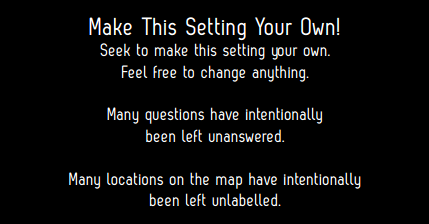
While that's not technically true (the "reveal" of why the Mechonids went haywire was revealed in the Protagonist Archive), it's still nice to see, and really that's the only revealed secret. It reminds me of how things were done in Eberron, where Keith Baker set up a bunch of big mysteries in the setting then left the answers up to each individual GM to answer to their own preferences.
Enough preamble. Let's start talking about the races, starting with...
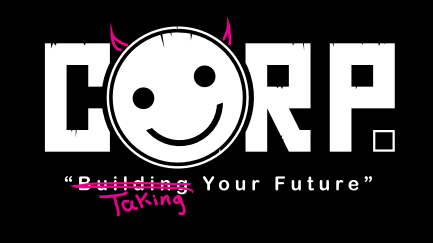
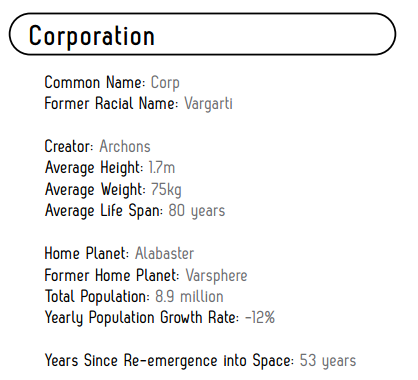
Each race gets a generalized demographic block, describing the usual generalities you'd expect; average height/weight, homeworld, common characteristics, things like that. We also get a listing for the races' current population and annual growth rate. This is actually kind of important, because (as we've seen, and will see again) not all the races were built to breed at high numbers. For example, the current Corp population is 8.9 million, but their population growth rate is actually -12% per year. To put that in a bit of perspective, the current human population growth rate is 2%/year.
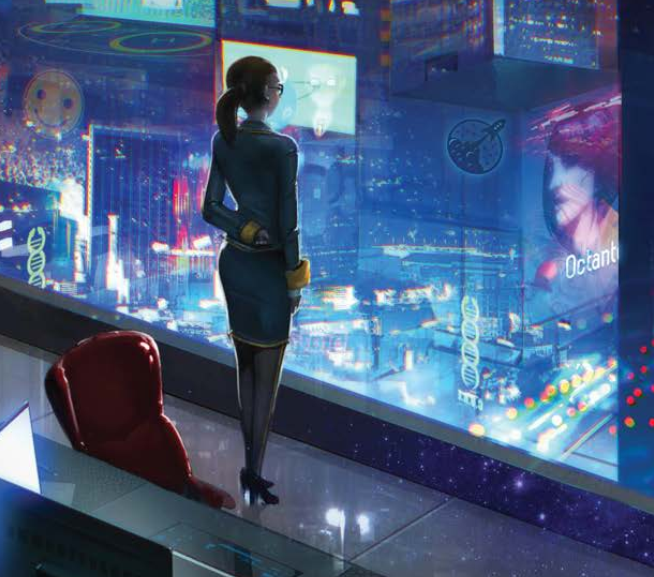
...and she saw that it was good.
The Corporation were once known as the Vargarti, and were one of the Archon's earlier attempts at creating their "perfect race". Unfortunately, the Archons saw the Vargarti as failures for some reason that's never explained. As "punishment" for being engineered wrong, the Archons vastly reduced the Vargarti's ability to breed (hense the -12% growth rate) and gave their homeworld of Varsphere to another Archon-created race, the Ursai.
The Usrasi didn't treat the Vargarti any better than the Archons did, pushing them to live on a single continent and using them as slaves. When the Great War happened, X'ion used targeted viruses to wipe out the primary race on Varsphere: the Ursai. So thanks to X'ion, the Vargarti got their homeworld back. Unfortunately, it was full of X'ion monstrosities, and even through they weren't the primary target they still suffered millions of losses. The Vargarti had no choice but to leave the planet.
quote:
For the Vargarti, the Years of Darkness were a chance to reimagine themselves and discard the inferior status given to them by the Archons. This re-imagining began when a small group of Vargarti warlords uncovered a ruin of an ancient city from the Golden Age of Humanity and learned of an ideology called capitalism. Embracing this ideology as a means to forge their own path, these warlords united the Vargarti tribes under a new identity: the Corporation. This became a purely capitalistic society, where each person succeeded or failed based on their own ability.
As I've mentioned before, the Corporation aren't one big lower-case "c" corporation. There are hundreds of different companies, each one pretty much a government unto itself; it's really more of a cartel than anything else. The Corp are the only race that see the Great War as a good thing, since it freed them from being treated as garbage by their creators. They embraced the principles of capitalism since "everyone succeeds or fails based on their ability" sounds really appealing to a race that was flat-out told they were created wrong. Unfortunately, they've taken it too far; the entire culture is based around greed and profit, and if you fail, well...that's on you. You had every opportunity to succeed, but you didn't take it. Maybe if you work harder you'll move up the corporate ladder someday.
Something something American dream. Occupy Haven, and so on.
The overarching government of the Corporation is described as a "plutocratic oligarchy": a small group of the richest people (since that's how the Corps measure a person's worth) run the show. The governing body is called the "Board of Directors" (big shock), and membership is determined each year by figuring out the ten wealthiest companies each year, and putting those CEOs on the Board. Unsurprisingly, this means that come Board members have been on the Board for years as the top dogs tend to stay on top, while other seats change constantly as the bottom five best corporations tend to change pretty frequently.
The Board is responsible for setting both regulatory and general law. It's important to note that law enforcement is handled via private companies, and instead of things like prison time, most crimes are punishable by fines. If you can't pay the fine, you can wind up in indentured servitude to the company you "wronged" until you pay off the fine. And damages. And legal fees. Oh, and they're probably housing and feeding you too so you have to pay for that. What really makes this fucked up is that the punishment doesn't fit the ethics of the crime, it fits the financial cost of the crime. The punishment for murder can vary depending on the perceived or actual financial value of the victim, regardless of who that victim is. You shoot a Kaltoran in someone's store? Eh, call it 50cr for "inconviencing business". Killing a successful CEO, though? That can cost you millions. Of course, if it's a CEO of a failing company, then the fine would be a lot less.
Of course, this means that the legal system isn't so much worried about guilt or motivation. A trial for murdering a CEO isn't really about the defendant's guilt or innocence, but about how much impact this'll have on the economy at large.
quote:
The court speaks to our online Stream audience “We now return to the thrilling pay-per-view court!” Above the judge’s bench hangs a flashing neon sign, which reads “ProtectronTM Pistol”. A billboard for Draz Soda clings to the podium. The judge speaks. “Mr Collins, you have pleaded guilty of costing CorpSafe millions of Credits in life insurance and stock. Mr Collins, what assurance have you for the court that these liabilities will be paid?”
Collins’s lawyer stands and while looking directly at the camera says, “Mr Friendly of Criminal Liabilities Firm (We protect your caper), for the defendant.” He then turns to the judge. “Your honour, I refer you to exhibit D-1, a contract signed by both my client and the Body Count Conglomerate for the assassination of the CorpSafe CEO. In clause 112, the Conglomerate clearly indemnifies my client against any financial liabilities directly resulting from the homicide.”
The Judge responds “Is a representative of Body Count here today?”
“Yes, your honour. Peters of CorpLaw (Biggest, and Best!), stand for The Body Count Conglomerate.”
As the newcomer takes the floor, the animated Draz billboard flashes “Only 1.99cr”. The CorpLaw lawyer speaks. “Your honour, had Collins fully upheld his end of the contract, we wouldn’t be having this conversation. Clause 233a of that same contract required that Mr Collins not be caught. By his negligence, not only has he left his contract unfulfilled by being captured, but he has also cost the reputation of Body Count by having his contract made public knowledge through this hearing. Your honour, we submit that the indemnity clause no longer applies and that the defendant is personally liable for both CorpSafe’s life expenses and for real and punitive damages to my client.”
His lawyer cautions him, but Collins speaks in his own defence. “Your honour, I have provided a copy of my credentials to you. In addition to my record I will take you and the court step by step through my successful assassination. This will be corroborated by a video recording taken from my own camera. You will see from this footage and my statement that I have upheld clause 233a, making every reasonable effort to remain uncaught, therefore maintaining Body Count’s liability.”
The judge declares, “Very well. The court will review this new evidence to determine whether the liability rests with the defendant or Body Count…” The judge smiles at the camera “… after this short ad break.”
Despite their rather...confrontational society, the Corp get along more-or-less okay with the other races. Partially because racism is bad for business, but mainly because what the Corp really want is stability. It's not exactly a secret that the Corp understand the need for inter-species cohesion probably better than anyone, and so far they're the only ones who've taken any real steps towards getting everything working.
The Corp get along best with the Nephelim, who were instrumental in helping the Corp get situated in the Haven system. The Nephelim also helped kickstart industrial development by the gift of Flesh Drone Workers (basically a vat-grown "robot" that can do simple manual labor or work assembly lines). They also get along surprisingly well with the Legion, mainly because each race takes care of what the other one doesn't want to deal with: the Corp hate the physical risk needed to explore the galaxy, while the Legion don't give a shit about things like manufacturing or economics. Legion tend to see a lot of employment on Corp planets and bases as security personell.
As for the Kaltorans...that's a different story. Back before the war, the Karltorans were the Archon's favorite creation while they were neutered and effectively dumped in the garbage. Now, the Corp are the galaxy's biggest player while the Kaltorans are still pretty much digging themselves out of the rubble. It's kinda hard to not be smug about that. Still, the Corp try to maintain trade relations for things like food and raw materials. The main problem there being that the Kaltorans don't really care about contracts, and tend to break them whenever they feel like it.
As stated before, the Corp are the biggest economic force in the galaxy. Hell, without them there probably wouldn't be an economy (or infrastructure) in the first place. The Corp were responsible for setting up the currency standard of the Credit and for getting interplanetary trade rolling. They're also a main driving force in technological development, although more in a "paying people to go out and find stuff" way than actually developing it themselves. Not to say they haven't created anything, it's just that their own R&D is focused on products they can wring a profit out of.
It should go wothout saying that the Corporation are currently dealing with a severe 1%-er/99%-er problem. "Work hard and you'll succeed" is one of those ideas that sounds good on paper, but in practice what hard work gets you is just more work. And while there isn't an exact 1%/99% split, the people on the lower end of the totem pole are starting to get a bit more proactive with fighting back. A terrorist organization calling itself UNITY has begun popping up to fight against the stranglehold the corporations have on their race's culture. UNITY's basic stance is "workers of the world, unite and kill the powerholders," so it's nice to see the Corporation has their own Commie menace to deal with.
At the end of the day, though, most of Corp culture is based around how they were treated by the Archons. They were told they were a failed experiment, they were treated like garbage, and they're the only created race that has no inherent genetic advantages whatsoever. This drives them hard to prove themselves and keep proving themselves, pretty much to the detriment of everything else. Corporate warfare is rapidly leaving the boardroom and turning more and more into actual warfare, and the various companies are acting pretty much how you'd expect given there's no such thing as any form of governmental oversight.
On the flip side of the coin are the Kaltorans.
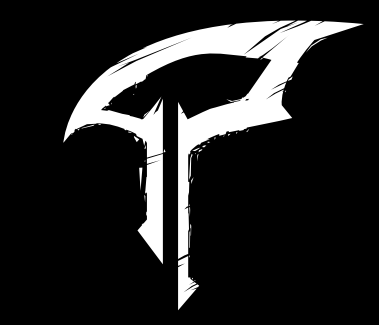
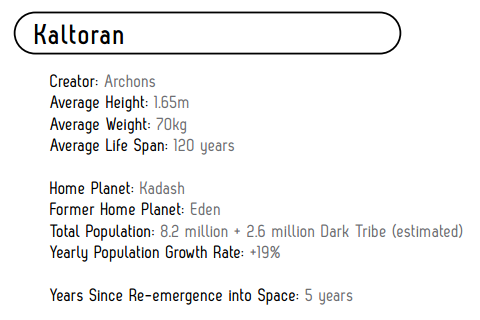
As we've seen many times before, the Kaltorans were the Archon's favorite children. Unfortunately, this favortism caused them to become one of X'ion's primary targets right after the Archons themselves. The Kaltoran homeworld of Eden was the subject of orbital bombing and Nephelim monstrocities being loosed on the surface of the planet. By the end of the Great War, Eden was transformed from a paradise to a monster-strewn wasteland.
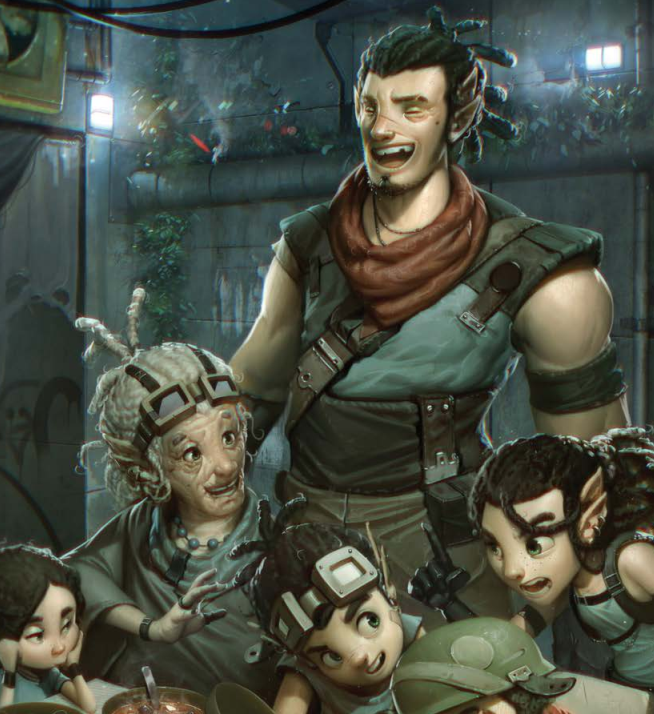
Here, you're family.
In order to survive, the Kaltorans moved underground. Or, to be more precise, underwater. Settlements were hurriedly built under the seas of Eden, and the population retreated to the relative safety of the darkness. Once there, the "Dark Tribes" began descending into paranoid savagery. Survival was difficult even without considering the Nephelim, and as the Kaltorans gathered into tribes they began to take on a very dangerous "us or them" mentality. Your family was everything, and anyone not in your family was a potential threat, if for no other reason because they were competition for scarce resources. Slavery and cannibalism became commonplace as the Kaltorans spent years turning on themselves.
To make matters worse was the Kaltoran's inherent genetic ability: genetic memory. Every Kaltoran is born with "seeded" memories from their parents, and their parents before them, and so on. This means that a Kaltoran can all upon the skills and knowledge of his entire family line, although the older the ancestor the harder it is to pull those memories. In game terms, this means that a Kaltorans reduce the penalty for an untrained Primary Skill roll by 1. The downside (again, in game terms) is that if a Kaltoran rolls triples on a Fate reroll, they immediately gain a minor psychological Condition as they're overwhelmed by memories.
This drawback ended up exacerbating the situation down in the caves. Each new generation was implanted with the memories of the war and the terrible things their parents had to do to survive, then that generation went out to create more terrible memories, which would be passed down to their children, and so on and so on.
Fortunately, the cycle was broken when the most recent generation decided they were done living in fear in the dark. This kicked off the Founding; an attempt to start building back upwards to reclaim the surface of Eden and take the planet back. This happened to coincide with the Corporation making contact with Eden, telling the Kaltorans that the war was long over.
Rather than try to fight back against the feral Nephlim occupying the surface and waste time trying to reclaim a destroyed planet, the newest generation of Kaltorans instead decided to spread out through the galaxy to gain new experiences and pass better memories down to their descendents. They've claimed the planet Kadash as their "new" homeworld, leaving Eden to the Nephelim.
The Kaltorans don't have any form of central government; instead they operate on what can best be described as a clan system. Each Kaltoran family is pretty much its own deal, with one member of the family appointed as its Elder (who may not necessarily be the oldest), and when something requires multiple families to get politically involved it's handled by the Elders.
This system does result in a culture that doesn't really have any consistency across itself. Since there's no formalized government, legality is more a vague concept based around general morality than something codified into laws. Minor crimes tend to be ignored if they don't really have a significant impact, but when a serious crime is commited, they'll come down hard.
When you get right down to it, the primary unit of Kaltoran culture is the family, and Kaltoran families tend to be pretty big. Sticking by your family was the only thing that got them through the last century, because without them you were pretty much fucked. And while survival isn't as big a concern as it used to be, it's hard to break out of that mindset after a century. Especially when you have the memories of the last three generations in your head.
The biggest problem that the Kaltorans have with re-integrating into the Haven system is, not to put too fine a point on it, everyone else. Kaltorans don't get along well with the Corporation because their cultures don't mesh at all. The Corps are all about profit, contracts, and control, but the Kaltorans operate on a barter system, handshake promices, and just doing whatever. Of course, it doesn't help that the Corps are pretty smug about how they're at the head of the table while the once-favored Kaltorans are scrabbling their way out of the dirt.
Likewise, it's really hard for most Kaltorans to accept the idea that the Nephelim don't want to fight anymore and they're supposed to be friends. Even for the Kaltorans who were born decades after their race was forced into hiding, the passed-down memories are hard to shake off. Not helping matters is the fact that the Nephelim have claimed Eden as their own.
The only race the Kaltorans really get along with are the Legion, mainly because they don't have much of a shared history. The Legion and Kaltorans have the political equivalent of a "nod at each other in the hallway" agreement. They respect each other, but aren't really going out of their way to do anything in regards to each other.
One thing that needs to be brought up about the Kaltorans before we wrap this up: the Dark Tribes still exist on Eden. The Kaltorans have left a lot of technology and cultural artifacts behind in their exodus, but the most war-worn survivalists refuse to leave the tunnels and underwater domes. The constant fighting and mental damage caused by handed down traumatic memories has resulted in the Kaltoran tunnels looking like the wrong end of a Rob Zombie movie. Forgotten, ruined tunnels are patrolled by warring clans of blind batshit insane cannibal survivalists who are masters of fighting in the dark, ambushes, and who see everyone who's not part of their family as a world-ending threat and, eventually, food. So far, nobody's been able to get salvage teams down there without getting said teams wiped out and eaten. And while the younger Kaltorans are more interested in experiencing new things than reclaiming the past, it's still a situation where they've been forced to turn their back on their own history for the sake of their own survival.
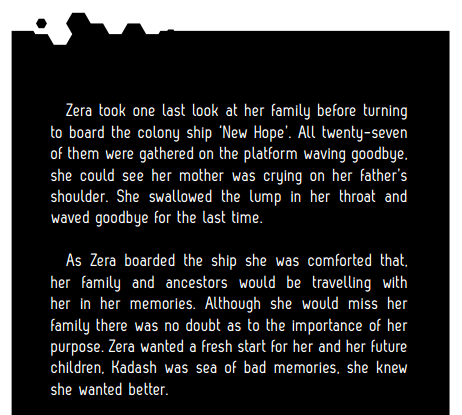
And since we're getting a bit long, we'll stop here. I don't really need to point out how the Corps and the Kaltorans are opposites in a lot of ways, but I do have to say I like how one is a reflection of the other in a lot of ways. The rise of the Corp versus the fall of the Kaltorans, the opposite view of culture, and (more interestingly), how the Corp are starting to enter a slow decline while the Kaltorans are starting to try to rise again. Of course, the same sort of "similarity of opposites" thing happens with the Legion and the Nephelim, but we'll talk about that more...
NEXT TIME: Old soldiers.
The Haven Races, Part 2
Original SA post
Part Seven: The Haven Races, Part 2
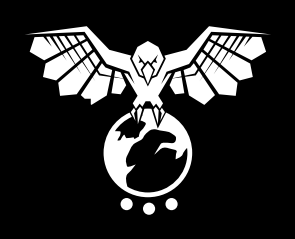
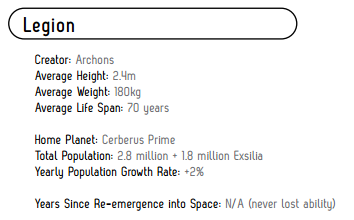
The Legion are, when you get right down to it, a bioweapon.
As a species, the Legion have only existed for about 100 years, having been created by the Archons specifically to fight X'ion's forces. And, well, we know how that turned out.
When the last of the Archons was killed, the Legion continued fighting the Nephilim for a few more decades, presumably because those were the last orders they received from their creators. But it was only a matter of time that, with the Archons gone, supplies and numbers began to run low. The Legion realized that the only way they would be able to avoid dying out completely was to do something rather drastic: create their own culture from scratch. After all, not only were they designed to be nothing but soldiers, they knew they were designed to be nothing but soldiers.
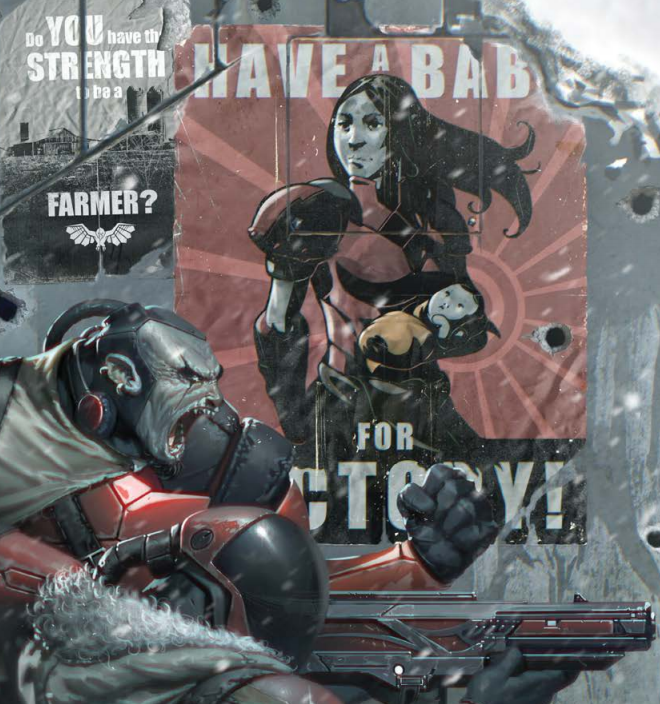
When all you have is a rifle, every problem looks like a target.
The Legion fleet used the last of its fuel to reach an arctic world they named "Cerberus" and began to create settlements. This was a lot harder than you'd think; the Legion were bred for war and as such weren't given the knowledge needed to do things like arctic farming (or farming in general, really) or setting up familial units. Because the Legion viewed everything through a military viewpoint, the Casila Curia (the central command) created a special branch of the military called the Interior Branch to basically try and figure out this whole "society" thing as they went along.
The Legion thought that they were the last of the Archon-created races in the galaxy until about 10 years ago when the Corporation made first contact. This...didn't go well. Not only were the Corporation allied with the Nephilim, the Corp and the Legion have vastly different cultures. While the Legion command was still trying to set up an actual alliance, numerous corporations were already hiring Legion as mercs. In an attempt to regain control of things, the Casila Curia branded everyone who signed up with the Corp as exiles and forbade them to ever return to Cerberus.
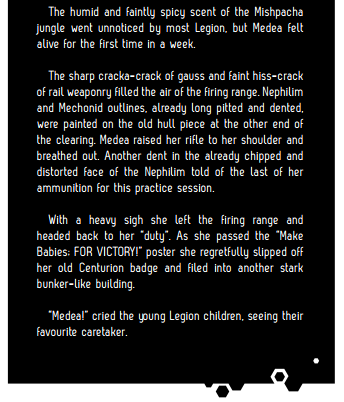
This had the unfortunate effect of disrupting the trade between the Corporation and the Legion, who were in need of the resources the Corporation could provide. Once again the government created a new military branch (the Foreign Branch) and a new army that could be hired out as mercenaries with the government's blessing: the Auxilia. The Auxilia was a way for exiles to be re-accepted back into Legion culture, and were set up on a new colony in the Haven system.
It should go without saying at this point that the Legion are a very structured culture, but what's most interesting is that the greatest heroes aren't the best soldiers. Without a vast war to fight, the Legion needed to readjust their thinking in very unfamiliar ways.
quote:
Because they were created as a warrior race, they place a heavy emphasis on duty, honour, and glory, which come from military service and involvement in combat. When the Great War ended, the Legion had to reinvent its society to accommodate peacetime professions and family. Taking on a civilian role is seen as a noble sacrifice, raising a family being the most noble sacrifice of all.
All that said, the inherent Legion mindset is to follow command structures and chains of command. Loyalty is very important to Legion, even the mercs; if pressed, a Legion will always follow their commander over their client. The Legion also place a high store on honor: they will generally attempt to keep collateral damage to a minimum, not attack civilians, or retreat without orders. That said, "honor" only goes so far. They're not above ambushes or fighting dirty if that's what's needed to get the job done.
The Legion's government is, unsurprisingly, a military structure. Really it's best described as a benign military dictatorship; the military high command is the government. At the core is the Casila Curia, which consists of the heads of the five military branches:
- The Army, which protects Cerberus Prime, and fights the Legion's enemies.
- The Navy, which is like the Army but with spaceships.
- The Interior Branch, who handle all non-military activity such as housing and food production.
- The Operations Branch, who handle intelligence and black ops.
- The Foreign Branch, who are not only in charge of hiring out Legion as mercenaries, but are also in charge of trade and diplomatic needs.
Now, given all this, it's not much of a stretch to realize that Legion will often wind up on both sides of a conflict. It's worth pointing out that in such a situation, the Legion don't see things as a conflict of interest. Granted, they'll be more likely to take their opponents alive if possible, but they wouldn't have an issue killing each other since, from their point of view, both sides are being honorable by sticking by their employer's and/or commander's orders.
The only branch leader who lives in the Haven system is the head of the Foreign Branch. Athene Kosta (a.k.a. "Lady Vengeance") stays in the Haven system to ease the interactions between the Legion and the other races. She earned her nickname due to her tendency to break protocol and lead from the front. She's the commander of all Legion forces in the system, including (in her eyes) the Exsilia. She considers them "misguided" rather than traitors, and will offer pardons to those Exsilia who want to rejoin. That said, those who refuse the offer are treated as willing traitors and are dealt with appropriately.
The Legion's relationships with the other races can best be described as "professional". The species the Legion has the most business with is the Corporation, who hire mercs from the Foreign Branch to serve as corporate muscle. In fact, about half the Foreign Branch are mercs.
The Legion gets along fine with the Kaltorians; due to their background the Legion feels it's their duty to protect the chosen creation of the Archons. The two races also have a sort of salvage-trade agreement: since both races rely heavily on salvage for technological resources, the Kaltorians trade old Legion ships they find for any non-Legion salvage the Legion find.
And as for the Nephilim...well...that's a little tricky. After all, even though everyone wants peace now, it's hard to completely forgive someone you actually made specifically to fight. The Legion understand that the Nephilim are needed as part of the new galactic culture, but still, it's hard to forget everything that happened. Not helping matters is that some Legion can't (or won't bother trying to) differentiate between the Nephilim who want peace and the "feral" Nephilim who are basically insane untethered war machines.
The Legion's biggest problem right now is that they're in a similar boat to the Corporation: they weren't designed to be a sustainable race, and as such their numbers are dwindling. They don't have the population drop-off that the Corproration have, but still, they weren't designed to breed and thus have a low fertility rate. On top of that, they (as a species) spend most of their time in combat. As a result, the high command have instituted what ammounts to a breeding program in order to keep the Legion population at a sustainable level. It's important to point out, though, that this isn't a Handmaiden's Tale stuation where they're keeping a bunch of female Legion aside solely to pump out babies. Instead, it's treated as just another assigned duty, albeit one that's more important than most, that you'll be assigned from time to time.
The second biggest problem the Legion are running into is their economy and infrastructure. Which is to say, they don't have good ones. The only real "export" they have are mercs, which is the backbone (and large percentage) of their economy. This also means that they're very depenant on the other races for pretty much everything. They do have some research and manufacturing going on, but it's very minimal; up until the end of the war everything was provided by the Archons so again this is all new to them.
Still, despite everything they're hanging on and fighting against destruction. After all, that's what they were designed to do.

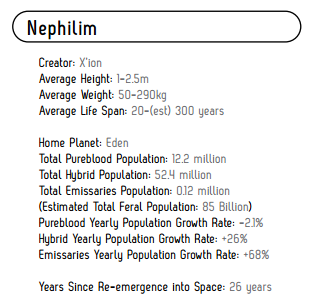
The Nephilim are, when you get right down to it, a bioweapon.
The Nephilim were made for one reason and one reason only: to destroy the Archons. And as we've already seen, they did so quite effectively; the Archons were rendered extinct within a century of X'ion's return to what's now known as "Haven space". X'ion's forces were organized by "broods", each of which had a unique speciality and purpose.
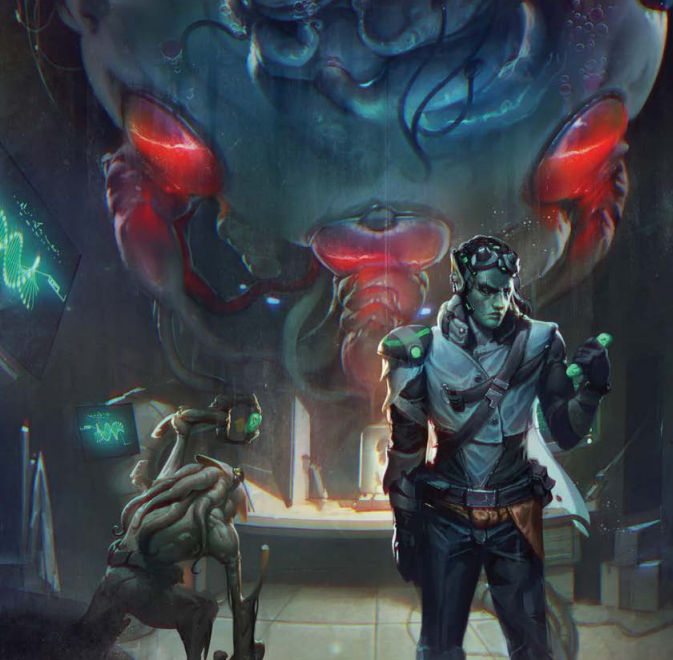
We are what we make ourselves to be.
One of these broods was the Devwi-Ich Brood, whose purpose was to destroy the Kaltorans due to that race being the Archon's favorite "children". And it nearly succeeded. The Kaltorans were wiped out across the system (with the exception of those who fled underground on Eded), and the Devwi-Itch Brood ruined the surface of Eden, the Kaltoran homeworld.
Then the war ended, and X'ion left, abandoning its children.
Devwi-Ich, now without Archons to kill or any ordered from its creator, crashed the bioships under its control onto Eden's surface to form a hive, and slept through the next century. While Devwi-Ich slept, the Nephilim under its control devolved without its guidance. Some formed into feral tribes, while others regressed into animalistic mindlessness. When Devwi-Ich awoke, it united the tribes across Eden, broke ties with X'ion, and determined that from now on, the Nephilim would live for themselves.
Like the Legion, the Nephilim didn't have anything resembling a culture until long after the war ended. Also like the Legion, the Nephilim are basing things on what they're familiar with. There are three main bullet points to the current culture:
- Life is Cheap: Since they're designed to kill, most Nephilim consider the lives of others to be pretty much valueless. Note that in this case "others" means "anyone who isn't the single Nephilim we're discussing right now." A Nephilim will consider their own life worth protecting, but everyone else (even other Nephilim) are on their own at best. The Nephilim leaders realize that this isn't exactly conductive to long-term survival of the species (or long-term alliances with anyone else) so they try to stamp that thinking down when they find it.
- Pursuit of Genetic Perfection: Because of their origins, the Nephilim are very heavily into the idea of "genetic superiority". Which is like survival of thei fittest, only instead of the strong ruling, it's the most genetically advantageous. Of course, this tends to translate to "the strongest" in any case. Unfortunately, this also leads to a eugenicist mindset where the bad genes are culled from the pool.
- Symbiotic Dependence: The Nephilim are incredibly dependant on the Devwi-Ich for overall survival, since everyone knows what happened to the race when it wasn't around to guide things. The Nephilims' inbuilt hostility and lack of social structure means they need someone to...keep them in line. Guide them. Tell them what to do. The Devwi-Ich knows it won't be around forever, and is slowly getting the Nephilim to become depenant on the other Haven races to introduce some much-needed cultural diversity
The Nephilim operate in a sort of pyramid of hierarchy: at the top is Devwi-Ich, and just below it are the Genocrats, which are the closest thing they have to a governing body. Technically speaking "genocrat" isn't even an official title; it's more of a "we need to call them something" name. Each one controls a specific territory or station, and they all answer directly to Devwi-Ich itself.
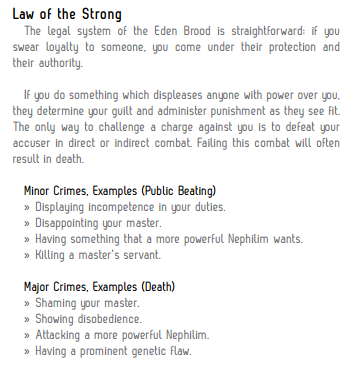
The biggest hurdle that the Nephilim are currently facing is the need to work with other races. The Eden Brood did ally themselves with the Corporation early on, for reasons (at the time) that only Devwi-Ich knew about. This was the only time the Nephilim assisted anyone with supplies, survival technologies, and the mindless vat-grown worker drones.
But while the Corporation were more than happy to join up with the race that wiped out the assholes that basically threw the Vargati into the garbage, the other races are a bit more...let's call it "hesitant" to make nice. After all, the Kaltorans were almost wiped out and the Legion were created specifically to fight the Nephilim. The Nephilim attitute towards the whole situation can best be summed up as "what, it was over 100 years ago, seriously, move on," which isn't helping.
In an attempt to ease alliances, the Nephilim have started creating a sub-species known as Emissaries. Emissaries are genetically grown and engineered to resemble the Corporation and Kaltorian standards of appearance (or specifically, attractiveness) in order to get people to like them more. To ease with social understanding, Emissaries are "raised" in a virtual reality simulation of what's generally considered a "normal" childhood so they can learn actual empathy and social skills. Their purpose, when you get right down to it, is to mingle. By spending time with the other Haven races, Emissaries help them acclimate to the existence of the Nepheilim as a whole.
Unfortunately, at the other end of the spectrum are the Feral Nephilim. This is what happens when the old Nephilim troops go too long without contact with a leader; they basically devolve into mindless killing machines. Devwi-Ich does seek to bring the Ferals "back into the fold" and help them regain their minds, but it also understands that some of them are too far gone, and doesn't hold it against the other races if they wipe out Feral colonies.
Unsurprisingly, the Nephilim are at the forefront of bio-technology. In fact, most Nephilim-created technology, from weapons to spaceships, are organic. More complex devices (like spaceships) are actually conglomerations of various organisms; a ship might have beetle-like drones that eat waste, then use that waste to repair the ship's hull. That's not to say that the Nephilim don't use non-organic technology. Since they don't have access to X'ion's vast construction methods, they've been force to start integrating mechanical or electronic systems into their bio-tech to "fill in the gaps".
Because of this, scientists are very common among the Nephilim. Most scientists operate on a personal level, and aren't afraid to experiemnt on themselves. Knowledge is power, and intellectual superiority is just as valued as physical strength. Between this and the overall Nephilim "life is cheap" mindset, let's just say that "medical ethics" is not something the Nephilim have rediscovered.
quote:
Nephilim scientists tend to believe that all things are permissible in the pursuit of scientific knowledge and personal advancement. Nephilim scientists often abduct unwilling test subjects and are happy to explore any technology, regardless of its potential for causing wider negative consequences. To the Nephilim, no research is unethical or too dangerous.
This amoral approach to acquiring knowledge and power is thought to be a result of not only their genetic predisposition towards self-advancement, but also their primal and violent culture.
One thing that does need to be pointed out is that the Nephilim are not genedered; they weren't really designed to reproduce naturally so there's no physical gender outside the Emissaries. While some pureblood Nephilim can lay or fertilize eggs, the race as a whole prefers gene splicing, artificial insemination, or the use of cloning vats because these are "less eratic" methods of procreation.
Still, despite every obstacle they're hanging on and fighting against their own destruction. After all, that's what they were designed to do.
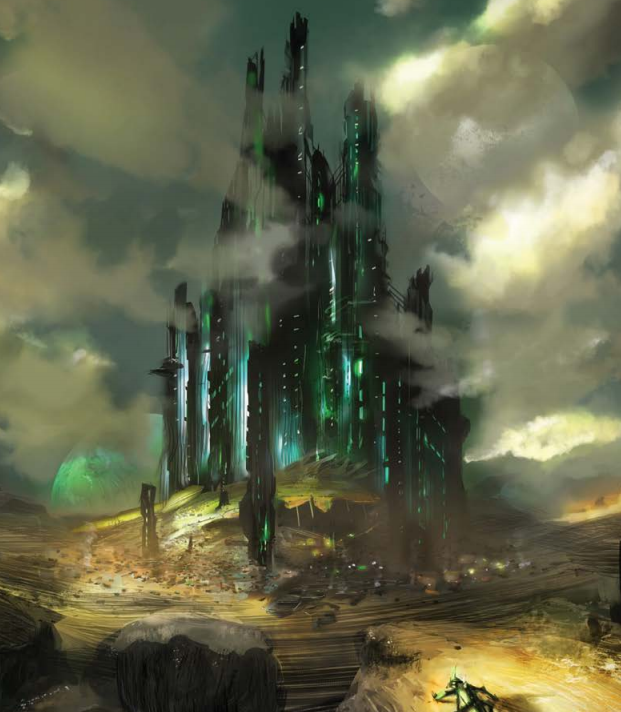
And that about covers the core Haven races. Again, I'm not getting into too much detail since this is a "current" game, but we can keep going with this chapter and hit the high points of some Places of Interest.
All of Fragged Empire takes place in what's referred to as the Habrixis Sector of space. This was the area where the Archons first settled and began creating all the new races. This sector hosts about two dozen star systems, a few nebulae, and other assorted lost features. There are three systems that are detailed in the book:
- The Haven System, which is the "core" of civilization. This used to be the home system of the Kaltorans, but it's become the center of the emerging civilizations.
- The Var System, which is the original home of the Corporation back when they were still the Vargati. Var was the equivalent of a garbage can that the Vargati were thrown into by the Archons when the Vargati were found to not be genetically perfect.
- The Cerberus System is the Legion home system, and is where the Legion central command is located. Despite the alliances between all the races, the Legion maintain Cerberus as a separate political entity.
Once again, I'm not going to go into depth on all the provided entries, but for the sake of summary I'll give a bullet-list of a few the types of places you can visit:
- Alabaster: Formerly known as Makor, this planet was a major Kaltoran pilgrimage site. Now owned by the Corporation, it's a major source of natrually generated starship fuel. The planet itself in uninhabitable, but there are six major space stations in orbit around the planet. Two of these stations are self-contained cities for the wealthiest of the Corp's citizens, while one went dark and was quarantined six years ago with tens of thousands of workers still trapped inside.
- Gehenna: The surface of this planet is mostly magma, and the atmosphere is mostly ash. The planet houses one of the largest mining facilities in the system, which were run by the Kaltorans at the behest of the Archons. But even back then, the working conditions were deplorable, and have only gotten worse over time. The Kaltorans have managed to keep the Corp from taking over (so far), and have also brought in some Legion personell to oversee and "motivate" the workers. It's only a matter of time before the whole thing collapses, and it's anyone's guess who's going to be there to pick up the pieces.
- Mishpacha: Another former Kaltoran world, Mishpacha is currently the only unclaimed world in the Haven system due to the large amount of monsters that resulted from the Nephilim bombing the planet with mutagens during the War. When X'ion left, it abandoned whole armies on Mishpacha, who have since devolved into feral tribes. Part of the planet has been reclaimed by the Haven races (the Nephilim in particular have an interest in "saving" the ferals and making them productive citizens), but the planet has become a popular hiding place for the worst criminals in the galaxy.
The rest of the chapter is breakdown of the overall technology levels of the setting. As has been stated before, the now-mythical "Golden Age of Humanity" was pretty much us hitting the singularity. In the current setting, most of what we created has been lost over the millennia, although large parts of our infrastructure remained behind. Humanity also terraformed most of the planets we came across, and even managed to use reality fractures to achieve FTL travel.
But while we did hit the peak of technological advancement, we also hit a point of generic erosion, which is what led to our eventual extinction. Being unable to find the cure for the problem, we created our replacement species: the Archons. But the relevant point here is that while the Archons were create to take over for us, they chose not to follow in our footsteps in regards to exploration and electronic-based technology. Instead, they turned their focus to genetics and the creation of new species.
Now that's not something that hasn't been mentioned here a bunch of times before. But here, the important takeaway is that the Archons turned their back on most of humanity's techonological discoveries. The Archons kept them maintained in remembrance of their creators, but did very little to innovate in non-genetic fields. When they were eventually wiped out by X'ion, the infrastructures of both the Archons and humanity were still around for the surviving races to discover.
Of course, there's a difference between "discovering" and "understanding". While the Haven races (particularly the Corporation) have manged to get the old human technology working again, there's even more that's not understood or even lost. The Corporation and the Nephilim are the races focused on understanding all this old tech, but even now there's a lot they don't understand about what's out there.
Once the generalities are out of the way, the books deals in specifics of things like what day-to-day tech use is like. Things like food production, communications, the currency system, things like that. Again, I'm skipping things here since a) this is a "current" book and b) this is getting long, but I do want to point out some stuff about long-range communication since it informs large parts of the setting.
Despite the fact that (admittedly limited) FTL travel exists, trans-system communication has a few problems. To wit: there's no real large scale mass communication system in place anywhere. For singular locations (like a city or a space station), there's usually some sort of comm system/internet in place. But once you start scaling out, the technical problems come to the fore.
Communication between large-scale objects in close proximity (such as a ship and a space station, a station and the planets surface, and so on) is handled via simple radio transmission. The problem with this, however, is that it doesn't work well over longer distances. Or even shorter ones, sometimes, due to the rarity of communication satellites. A radio connection between a city on a planet's surface and an orbital station can be blocked by the curvature of the planet as it rotates.
As for trans-system setups...there's really nothing. You can send a message out from the ass end of space, sure, but there'll be a delay. For every day of travel it would take you to reach your target, the comm signal is delayed an hour. This means that inter-system communications are difficult at best and completely impractical at worst.
This also means there's no "galactic internet" because there's no real way to send data across those distances. The makeshift solution is the "data hauling" industry. Actual physical hard drives full of data are shipped like trade goods between systems, which is not exactly what you'd call a generally useful method of data transfer.
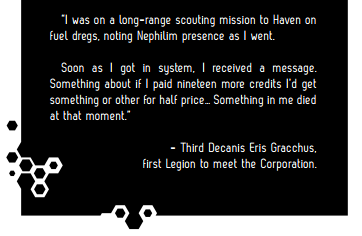
A few other high points:
- Electronics and mechanics are widespread, albeit not 100% understood. Advances are made, but since the Archons pretty much ignored these fields since humanity died out there's a lot of tech and concepts that are just...forgotten. Cybernetic implants exist, but aren't very widespread.
- Biotech is still in use, especially by the Nephilim. Medicine is particularly advanced, and cloning technologies exist but aren't trusted for the most part. The Nephilim have also developed "synaptronics": bio-technology used for computing purposes. Synaptronics allows for faster computing due to not being tied to a binary state, and also makes user-to-system neural interfacing possible.
- The ley lines are very poorly understood "cracks" in reality that happened sometime back when the humans began expanding their empire; in fact the ley lines are what allow for FTL travel in the first place.
- Psionics exist, but are very rare. All that's really known about what makes psionic powers possible is that there's a connection of some sort to the ley lines, and that it's a genetic ability. So far nobody's been able to artificially replicate whatever DNA twist it is that makes someone psionic. So far, psionic powers seem to be limited to telepathy, although some psis seem to be able to twist time a bit.
Of course, there's also all kinds of strange, unknown flotsam of multiple space empires floating around out there. Rogue AIs, aliens, forgotten species, lost technologies, and, somewhere out in the depths of space, X'ion itself.
But hey, if there weren't any unknown, dangerous, forgotten things littered across forgotten star systems, why the hell would you want to explore in the first place?
NEXT TIME: Running this thing
Gamemastering and Final Thoughts
Original SA post
Part Eight: Gamemastering and Final Thoughts
Now we come to the GM's Guide chapter, which is actually fairly short. Mostly it's about how to put together NPC and combats; in fact it's only about 20 pages long.
Part of the reason it's short is because the game assumes you know how to GM.
quote:
The Basics
It is assumed you already know what a Game Master is, how to prepare a story, and how to use non-player characters (NPCs) – GM skills used across all role playing games (RPGs). If you don’t know any of this, we recommend you join an existing group for a while. Ask your local gaming store.
This section will only teach you the specifics of GMing in the Fragged Empire system and setting.
Anyway, the chapter starts out by running through some basic GMing concepts, like deciding how you want your game to work (as in, do you want a combat-heavy game? Is the focus going to be exploration or merc work? Things like that.) Nothing we really haven't seen before.
But really, since the main mechanical focus of the game is combat, that's what this chapter is about. And there is some good advice here, such as rewarding the players if they come up with good tactics or how to make individual fights interesting.
Since managing a ton of NPCs in a fight can be rough, NPCs have their own optional set of combat actions to keep things simple for the GM.

And I can confirm that these make running combat easier; in my game I was able to keep a dozen NPCs running around and being a threat without a ton of options for dudes who're only going to be around for one fight. And since everything works off the same core actions, you can use these simpler actions for mooks and lower-tier enemies and let the big threats have access to the full list without really knocking things out of whack.
Which brings us to the section on balancing combat and making NPCs. NPCs come in three general categories:
- Henchmen are mooks, and are created in "groups" of four; they don't have any stats or Endurance, and act as a group at the end of a round. All they can do is move and attack, and the default group of four henchmen is the equivalent of one PC.
- Skilled opponents are the standard-issue NPC, and are the equivalent of one PC.
- Nemesis opponents are your serious threats; they're equivalent to three PCs.
quote:
Combat Should Never Be Perfectly Balanced
Do not attempt to make combat perfectly balanced; it is not meant to be. RPGs are about your player characters’ stories. While the player characters should win most fights, they should not expect to be able to defeat any NPC at any time.
But at the same time, the GM is told that there's a difference between "difficult unbalanced" and "unfair unbalanced". In other words, your job isn't to kill PCs.
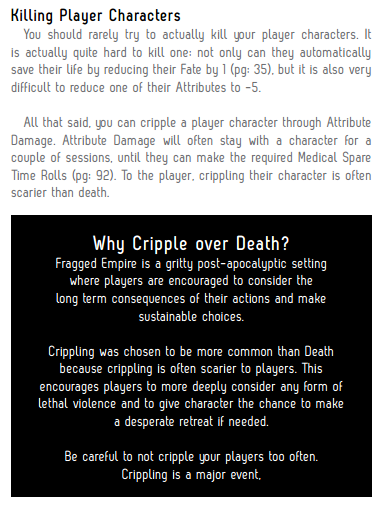
Creating NPCs is very simple. Each category of NPC has a default stat block, which gets modified by the average resources of the PCs and what traits they have.
For instance, a Skilled NPC starts with 14 stat points, 0 Fate, 3 Armor, their Race modifiers, one Trait, +2 to hit, and 2 Resources for weapons. They don't have skills, outfits or other gear, but on the plus side they don't worry about skill requirements for Traits.
Once you have that setup, you look at the provided table to see how their base stats are modified. So for low-Resource characters, you drop their Armor by 1, but for a more advanced group a Skilled opponent can have more gear, more Traits, or get a Variation.
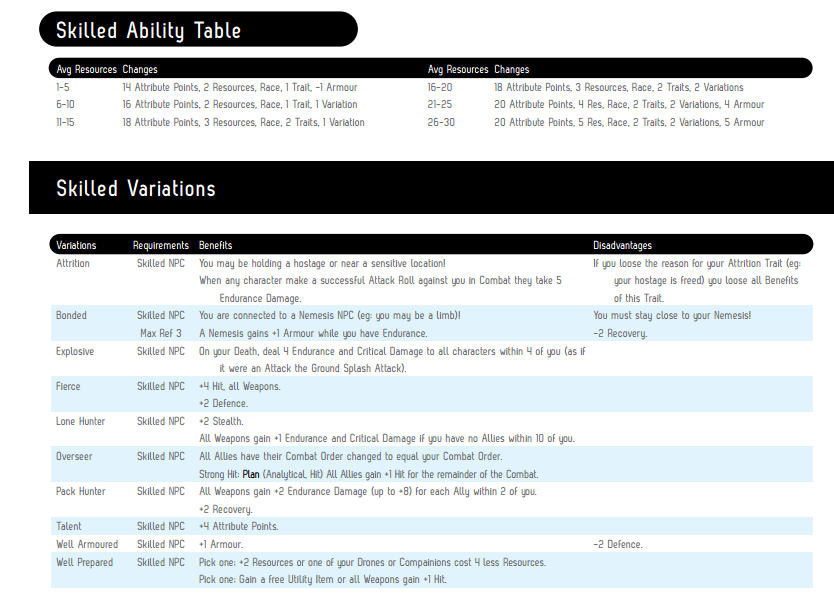
Options!
Nemesis opponents are built in the same fashion, but with higher numbers and more powerful Variations.
Henchmen, however, are a little different. Henchmen don't have stats at all, just Defense and Armor. If you hit them and get past their Armor, they drop. To make up for this, Henchmen have a stat called "Bodies" that is how many guys are in that particular group of mooks. Each mook group gets +Bodies to their End damage and RoF, but each individual group can only make a single move action and a single group attack per round.
There are also guidelines for NPC spacecraft, but there's no "default" ship stat block. Instead, the GM gets equal Influence to the PCs to build a ship, but with 20 stat points. The game does point out that spaceship combat should generally be one ship versus one ship, but you can have one ship versus two smaller ones.
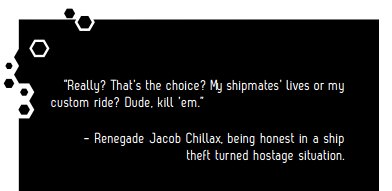
Next, we get some guidelines on rewarding the players. This is more about paying PCs rather than a leveling thing since everyone automatically levels every three sessions.
The main source of PC "advancement" is their Resources. followed closely by Influence. Generally, Resources will come by being paid for jobs or scavenging, whereas Influence will come from "freebie" jobs as your reputation improves. Other ways characters can get Resources are through Trade Goods or Research, and they way they get those is through exploration and/or looting.
quote:
Looting, Stealing, and Finding Things
Dealing with this can be tricky. Feel free to let players take items they find, but remind them that they can’t keep looted items that cost Resources or Influence for more than one session. Instead, they can turn looted items into Trade Goods, roughly 1 Trade Box per 4 Weight of items.
We close out with four one-page sample adventures. These are pretty straightforward, each one giving a background, some hooks, and the types of encounters to use. Some of these (like trying to hijack a cargo ship full of illegal drugs) aren't exactly what you'd call "starter adventures", but they're still good for getting a feel for the types of thing you can do in the setting
And that's pretty much it for the GMing chapter. Like I said, it's pretty short.
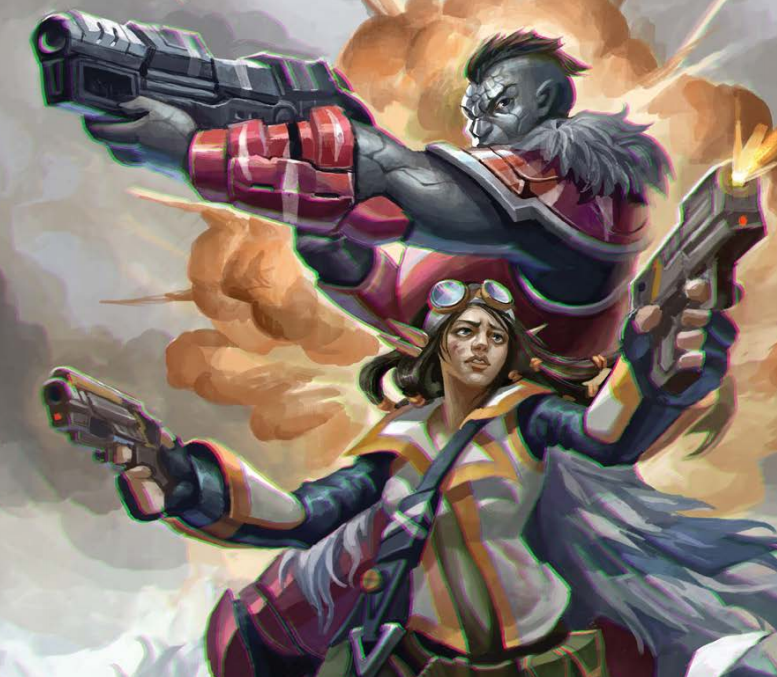
They fight crime!
The final chapter in the book is Opponents, and is your expected list of premade NPCs of the named and non-named variety. While the game expects the GM to put together NPCs that fit their specific needs most of the time, it's nice to have a few generics laying around to help seed ideas or to throw into a fight at the last second. The various NPCs are sorted into specific categories, which I appreciate: Mechonids, Feral Nephilim, Draz (urban drug-heads), and Enforcers.
Mechonids have been mentioned before: insane AIs in warmachine bodies dedicated to wiping out organic life. Here, we get more information on their backstory.
Near the end of the War, the Archons were getting desperate. As it became clear they were on the edge of extinction, they attempted to take an old human technology they never cared about and turn it into a new fighting force: robotics powered by AIs. The Archons had been maintaining most of the abandoned human technologies in memory of their creators, but never used any of it since they were more focused on genetics. But they eventually found old servers full of AIs, and downloaded these AIs into robots and factories, inexpertly programming them to fight in defense of the Archons.
quote:
It wasn’t long before the Archons realized that their mastery of bio-tech had not equipped them to control such ancient and advanced electronic technologies. The Mechonids side-stepped their mission parameters and took to extreme and vicious tactics, such as fighting with disabled nuclear-core shields, infecting their enemies’ environments with poisonous radiation. Then, for unknown reasons, they turned on their Archon masters, and began killing all sentient biological life without discrimination.
Once there were no sentient biological targets left to kill, the Mechonids went dormant. Their production facilities shut down, and their ships turned off their engines. It wasn’t until the Corporation arrived in the Haven system, filling the empty space with traffic and communication signals, that the Mechonids stirred once more.
Mechonids are a shit-your-pants level threat when they show up; not necessarily because they're powerful (although they do have "Bio-Disintegration" weapons, there are Mechonids for all character levels), but because everyone knows that they're a threat to all living things...and there's a hell of a lot more where they came from.
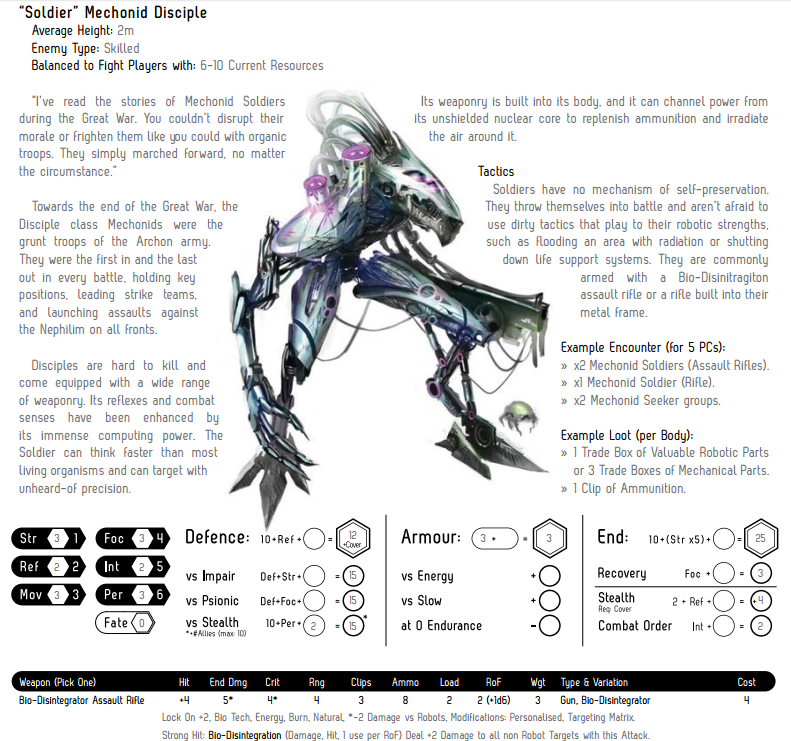
Feral Nephilim are those Nephilim who were abandoned when X'ion left but were never gathered up by Devw-Ich. Lacking enemies to fight or orders from, well, anyone, most of these Nephilim have fallen into tribal mindsets if they're lucky, or into kill-crazy mindlessness if they're not. Devw-Ich and the Nephilim often seek out tribes of Ferals to save them and help them discover who they can be, but sadly the only way to save many of the Ferals is to just put them down for their own good.
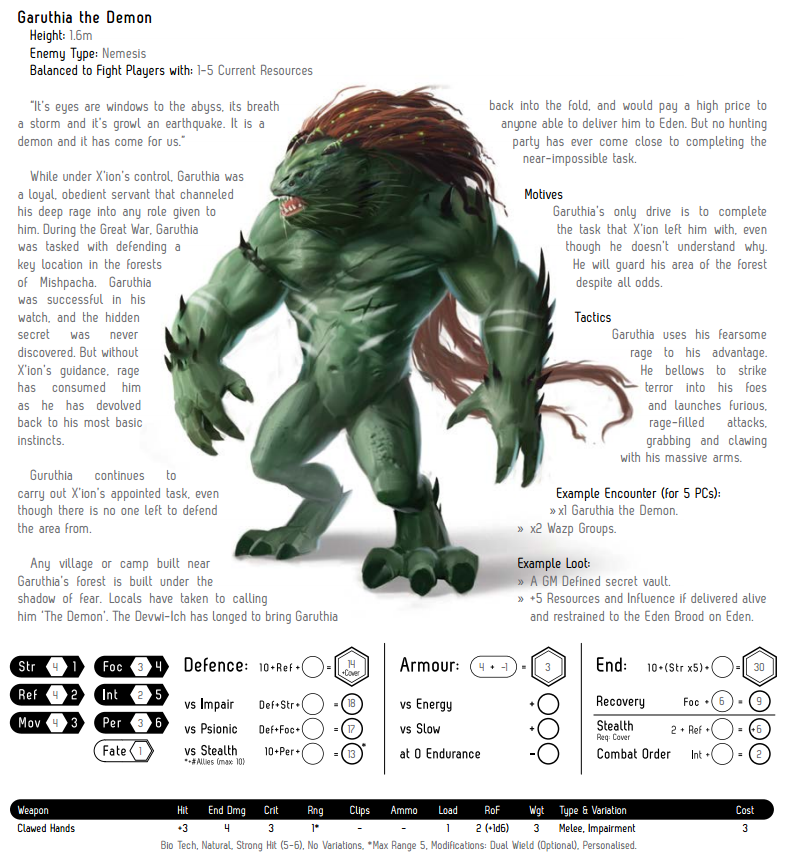
Draz is a very popular, very illegal, very addictive drug developed jointly by the Nephilim and the Corporation. It was originally created to be a controlled (by the Corp) substance that would boost the user's energy while addicting them to a substance under the Corp's control. And when prepared in a legal way, it's a popular energy drink.
When prepared in illegal ways...well...
quote:
When taken in small doses, Draz artificially replicates the body’s sleep patterns while keeping the user fully awake and cognisant. It produces the same chemical and hormonal effects as sleep, yet does not restore the body as a full night’s rest would.
When taken in a large or concentrated dose, Draz pumps the user’s body full of exotic, fast-working bio-replication mutagens. While this allows the body to shrug off almost any damage, it chips away at the user’s sanity and destroys their brain functions.
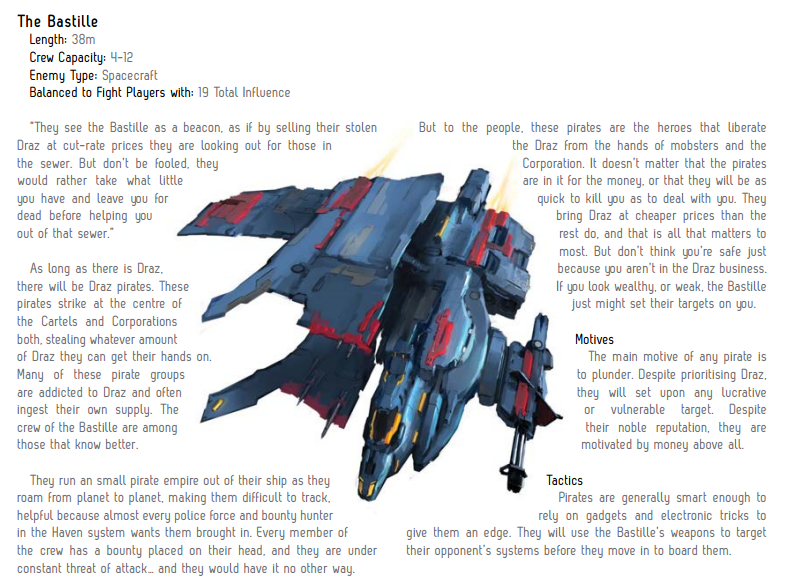
Enforcers are law officers, which is a term that's kind of hard to work with in the Haven system. There still isn't really an all-encompassing government in the way we'd think of for a sci-fi game. Every city or colony or space station can have their own rules about what's legal and what isn't. Most of civilized society has agreed on general concepts of what would be illegal, and those are the kinds of things you'd expect: theft, murder, and so on.
Out in the wilds of space, however, it's a different story. "Legal" tends to mean "what you can get away with without witnesses." That being said, crossing powerful individuals will still get you some heavy attention. A pirate who attacks a Corp shipping vessel is going to find himself the target of the Corporation's enforcers and/or Legion mercs. And where the enforcers fear to tread, you'll always find a bounty hunter or two willing to take the risk. For the right price, of course.
The other main problem with law enforcement is that each culture has a different idea of what the law should allow and how transgressions should be punished.
The general Corp mindset is "if it costs the Corp money, they'll fine you for small stuff and kill you for large stuff." Most law enforcement is handled through security contractors, but Legion mercenaries are often brought in when needed. It's not unknown for the Corporation to drop charges against someone after a cost-benefits analysis.
Kaltoran law is very loose; more than anything else it's about defending yourself and your family. Since every Kaltoran is well-armed, they've learned to let the small things go. Major crimes, on the other hand, are usually handled by a good old-fashioned hunting party. Complex crimes are handled by family Elders, who aren't afraid to have those who've wronged them executed in public. Don't go against the family.
The Legion have the most rigid legal structure (shocking, I know), designed to be fair and just. At least, fair and just for themselves. For everyone else, it's harsh and unforgiving. This isn't helped by the fact that the Legion see everyone else's legal setups as "unworthy", so the Legion will enforce Legion law regardless of who they're around or where they are.
As for the Nephilim, everything boils down to one concept: survival of the fittest. The strong rule, the weak are ignored. The closest thing to a crime in Nepilim society is when you piss off someone stronger than you, and 100% of the time the response is violence.
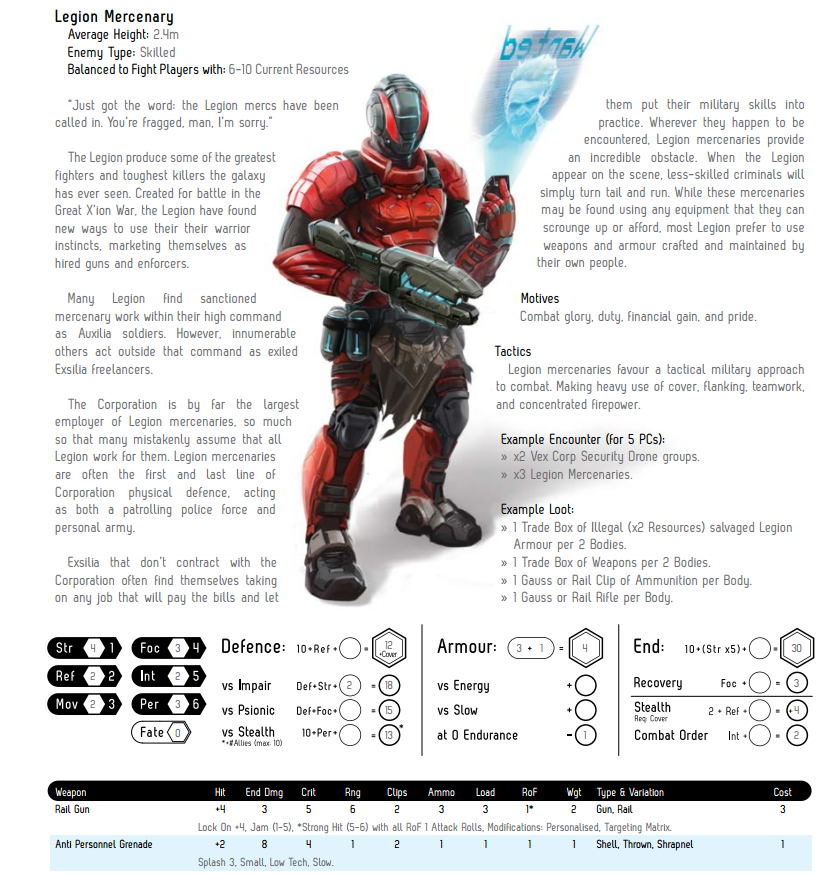
After the Opponents chapter, all that's left are the various character lists, which means we've reached the end of the review.
--
I don't think I'm going to shock anyone when I say I highly recommend this game.
While I admit it's crunchier than most of the games I like nowadays, it's crunch that serves a purpose. The weapon creation system bypasses the "best gun syndrome" problem many sci-fi RPGs have. The combat moves smoothly, thanks to the detailed combat actions. Spaceship combat handles all kinds of combats easily. NPC creation is really fun and easy to do. The combat is tactical without getting bogged down in details.
But what I love most, more than anything else is the setting. Each of the races are unique and well thought out, the backstory sets up a really interesting setting that encourages exploration, and it's a post-apocalyptic setup that's focused on hope and rebuilding.
I mean, yeah not all the races get along, yes there's conflict there. But it's interesting conflict. It's not a grimdark there-is-only-war thing we've all seen a million times before, it's about coming together despite internal and external threats.
You ask me, we need more games about people coming together.
Besides, who doesn't want to just tool around the galaxy being a hero and exploring forgotten worlds?
Fragged Empire currently has two supplements: the Antagonists Archive I, which is full of NPCs, places to go experience violence, and major organizations to run afoul of; and the Protagonists Archive I, which has a ton of new PC options including four new races. In addition, Wade is (as I write this) preparing to release three setting books that use Fragged Empire as a core:
Fragged Aeterneum is the world's first Soulsbourne RPG, where the characters are immortal respawning defenders of an infinite gothic city. The focus is on melee combat, and TPKs are not only expected, they're accounted for in the rules.
Fragged Seas is about pirates in a Chthuhlu-esque world; kind of like 7th Sea only up front about it. It has rules for dark-god-powered magic, naval battles, as well as more involved trading rules.
Fragged Kingdom is a fantasy RPG about exploration and kingdom building. It works off the old cliche of "this fantasy world is actually the distant future of a super-high-tech society that collapsed aeons ago, and all the magic is actually old technology", only the society that collapsed is Fragged Empire. Most of the Haven races are still around, only now they (you) get to create your own settlement.
Fragged Empire and its various supplements are available through various physical and digital vendors, as are things like minis and t-shirts.
Now, if you'll excuse me, there's a big ol' galaxy out there waiting to be explored. Pick a star and set a course.